 | –≠–ª–µ–∫—Ç—Ä–æ–Ω–Ω—ã–π –∫–æ–º–ø–æ–Ω–µ–Ω—Ç: LTC1624 | –°–∫–∞—á–∞—Ç—å:  PDF PDF  ZIP ZIP |
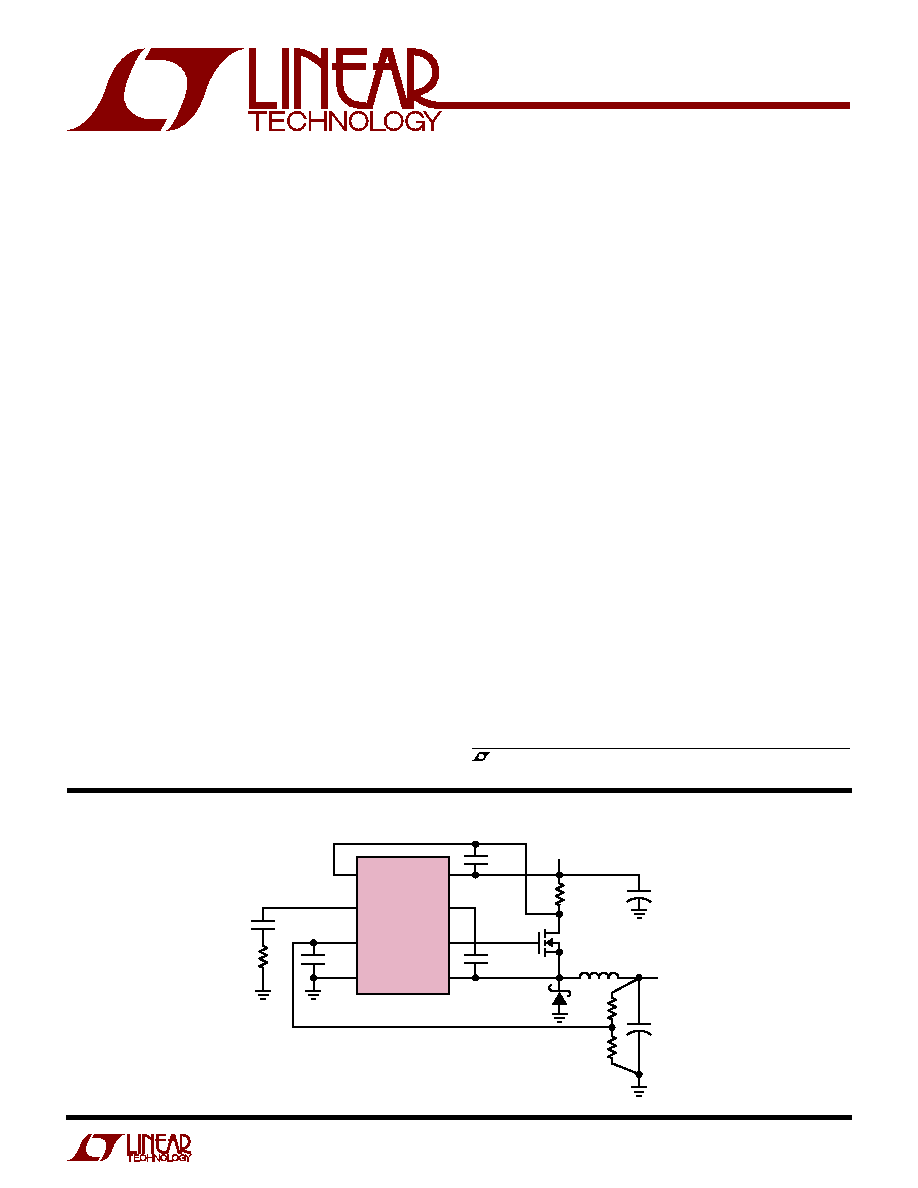
1
LTC1624
FEATURES
DESCRIPTIO
N
U
s
N-Channel MOSFET Drive
s
Implements Boost, Step-Down, SEPIC
and Inverting Regulators
s
Wide V
IN
Range: 3.5V to 36V Operation
s
Wide V
OUT
Range: 1.19V to 30V in Step-Down
Configuration
s
±
1% 1.19V Reference
s
Low Dropout Operation: 95% Duty Cycle
s
200kHz Fixed Frequency
s
Low Standby Current
s
Very High Efficiency
s
Remote Output Voltage Sense
s
Logic-Controlled Micropower Shutdown
s
Internal Diode for Bootstrapped Gate Drive
s
Current Mode Operation for Excellent Line and
Load Transient Response
s
Available in an 8-Lead SO Package
s
Notebook and Palmtop Computers, PDAs
s
Cellular Telephones and Wireless Modems
s
Battery-Operated Digital Devices
s
DC Power Distribution Systems
s
Battery Chargers
TYPICAL APPLICATIO
N
U
The LTC
Æ
1624 is a current mode switching regulator
controller that drives an external N-channel power MOSFET
using a fixed frequency architecture. It can be operated in
all standard switching configurations including boost,
step-down, inverting and SEPIC. Burst Mode
TM
operation
provides high efficiency at low load currents. A maximum
high duty cycle limit of 95% provides low dropout operation
which extends operating time in battery-operated systems.
The operating frequency is internally set to 200kHz, allowing
small inductor values and minimizing PC board space. The
operating current level is user-programmable via an external
current sense resistor. Wide input supply range allows
operation from 3.5V to 36V (absolute maximum).
A multifunction pin (I
TH
/ RUN) allows external
compensation for optimum load step response plus
shutdown. Soft start can also be implemented with the
I
TH
/RUN pin to properly sequence supplies.
Figure 1. High Efficiency Step-Down Converter
+
+
SENSE
≠
I
TH
/RUN
V
FB
GND
V
IN
BOOST
TG
SW
LTC1624
1000pF
100pF
C
C
470pF
R
C
6.8k
D1
MBRS340T3
C
B
0.1
µ
F
R2
35.7k
R1
20k
C
OUT
100
µ
F
10V
◊
2
M1
Si4412DY
L1
10
µ
H
R
SENSE
0.05
C
IN
22
µ
F
35V
◊
2
V
OUT
3.3V
2A
V
IN
4.8V TO 28V
1624 F01
, LTC and LT are registered trademarks of Linear Technology Corporation.
Burst Mode is a trademark of Linear Technology Corporation.
High Efficiency SO-8
N-Channel Switching
Regulator Controller
APPLICATIO
N
S
U
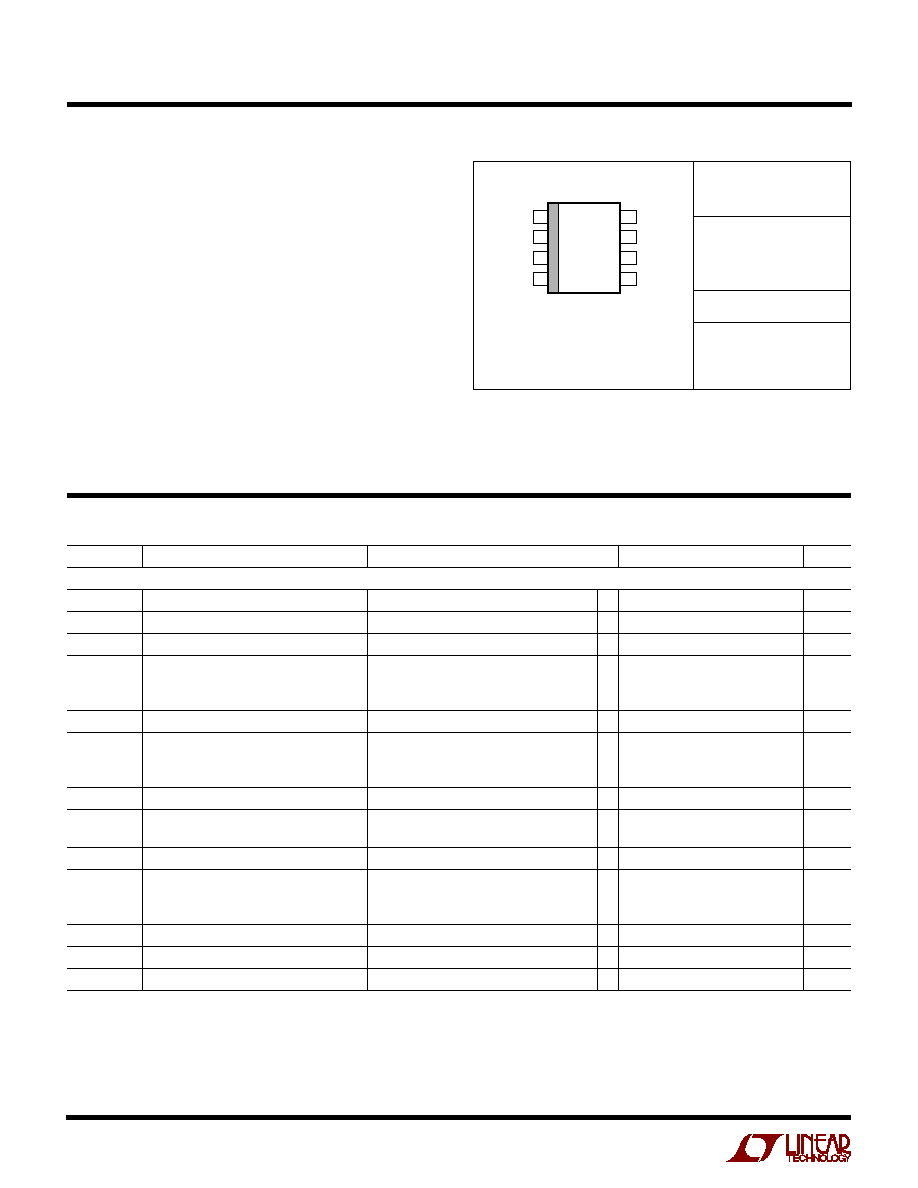
2
LTC1624
ABSOLUTE
M
AXI
M
U
M
RATINGS
W
W
W
U
Input Supply Voltage (V
IN
)......................... 36V to ≠ 0.3V
Topside Driver Supply Voltage (BOOST)....42V to ≠ 0.3V
Switch Voltage (SW).................................. 36V to ≠ 0.6V
Differential Boost Voltage
(BOOST to SW) ....................................7.8V to ≠ 0.3V
SENSE
≠
Voltage
V
IN
< 15V .................................. (V
IN
+ 0.3V) to ≠ 0.3V
V
IN
15V .......................... (V
IN
+0.3V) to (V
IN
≠ 15V)
I
TH
/RUN, V
FB
Voltages ............................ 2.7V to ≠ 0.3V
Peak Driver Output Current < 10
µ
s (TG) .................... 2A
Operating Temperature Range
LTC1624CS ............................................ 0
∞
C to 70
∞
C
LTC1624IS ......................................... ≠ 40
∞
C to 85
∞
C
Junction Temperature (Note 1)............................. 125
∞
C
Storage Temperature Range ................. ≠ 65
∞
C to 150
∞
C
Lead Temperature (Soldering, 10 sec).................. 300
∞
C
PACKAGE/ORDER I
N
FOR
M
ATIO
N
W
U
U
ORDER PART
NUMBER
S8 PART MARKING
TOP VIEW
V
IN
BOOST
TG
SW
SENSE
≠
I
TH
/RUN
V
FB
GND
S8 PACKAGE
8-LEAD PLASTIC SO
1
2
3
4
8
7
6
5
T
JMAX
= 125
∞
C,
JA
= 110
∞
C/ W
LTC1624CS8
LTC1624IS8
1624
1624I
Consult factory for Military grade parts.
ELECTRICAL CHARACTERISTICS
T
A
= 25
∞
C, V
IN
= 15V, unless otherwise noted.
SYMBOL
PARAMETER
CONDITIONS
MIN
TYP
MAX
UNITS
Main Control Loop
I
IN
V
FB
Feedback Current
(Note 2)
10
50
nA
V
FB
Feedback Voltage
(Note 2)
q
1.1781
1.19
1.2019
V
V
LINE REG
Reference Voltage Line Regulation
V
IN
= 3.6V to 20V (Note 2)
0.002
0.01
%/V
V
LOAD REG
Output Voltage Load Regulation
(Note 2)
I
TH
Sinking 5
µ
A
q
0.5
0.8
%
I
TH
Sourcing 5
µ
A
q
≠ 0.5
≠ 0.8
%
V
OVL
Output Overvoltage Lockout
1.24
1.28
1.32
V
I
Q
Input DC Supply Current
(Note 3)
Normal Mode
550
900
µ
A
Shutdown
V
ITH/RUN
= 0V
16
30
µ
A
V
ITH/RUN
Run Threshold
0.6
0.8
V
I
ITH/RUN
Run Current Source
V
ITH/RUN
= 0.3V
≠ 0.8
≠ 2.5
≠ 5.0
µ
A
Run Pullup Current
V
ITH/RUN
= 1V
≠ 50
≠160
≠ 350
µ
A
V
SENSE(MAX)
Maximum Current Sense Threshold
V
FB
= 1.0V
145
160
185
mV
TG Transition Time
TG t
r
Rise Time
C
LOAD
= 3000pF
50
150
ns
TG t
f
Fall Time
C
LOAD
= 3000pF
50
150
ns
f
OSC
Oscillator Frequency
q
175
200
225
kHz
V
BOOST
Boost Voltage
SW = 0V, I
BOOST
= 5mA, V
IN
= 8V
4.8
5.15
5.5
V
V
BOOST
Boost Load Regulation
SW = 0V, I
BOOST
= 2mA to 20mA
3
5
%
T
J
= T
A
+ (P
D
∑ 110
∞
C/W)
Note 2: The LTC1624 is tested in a feedback loop which servos V
FB
to
the midpoint for the error amplifier (V
ITH
= 1.8V).
Note 3: Dynamic supply current is higher due to the gate charge being
delivered at the switching frequency. See Applications Information.
The
q
denotes specifications which apply over the full operating
temperature range.
LTC1624CS: 0
∞
C
T
A
70
∞
C
LTC1624IS: ≠ 40
∞
C
T
A
85
∞
C
Note 1: T
J
is calculated from the ambient temperature T
A
and power
dissipation P
D
according to the following formula:
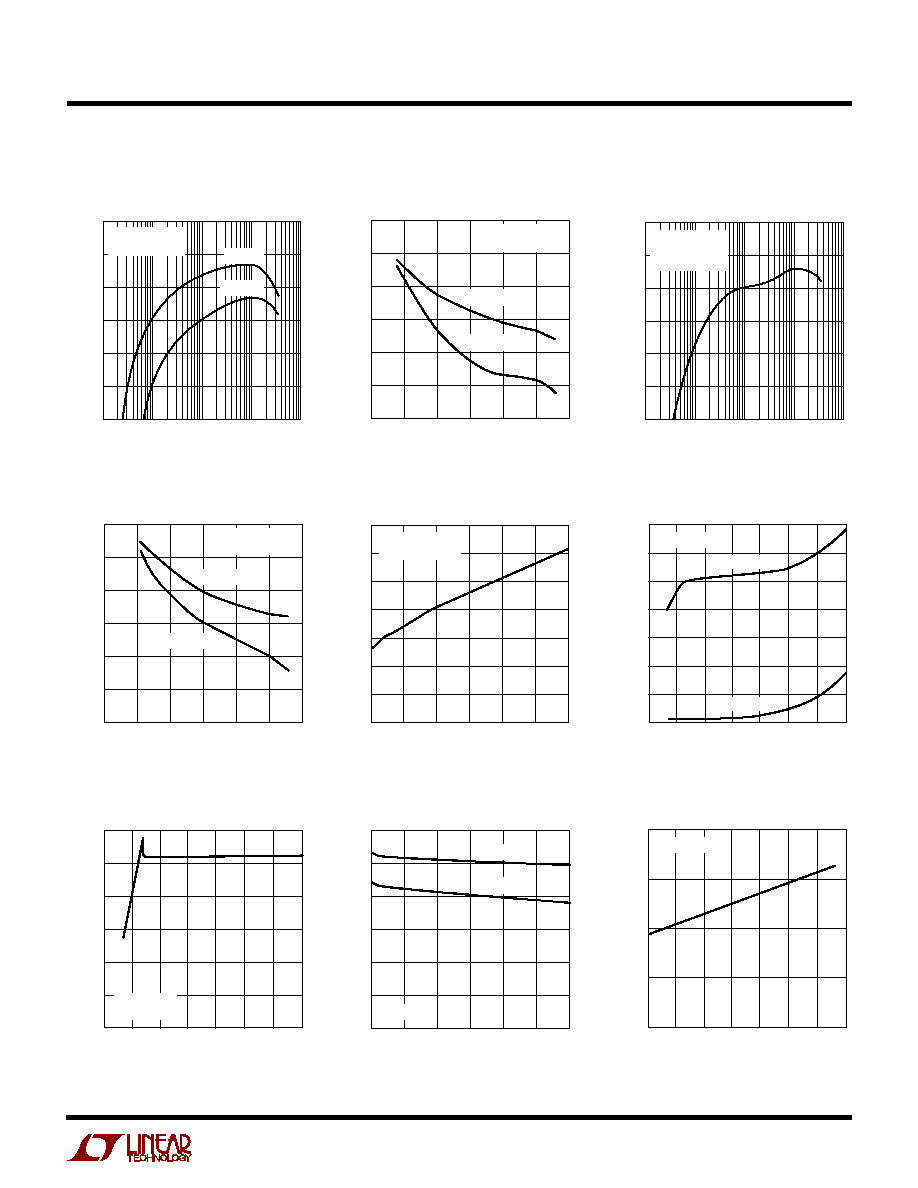
3
LTC1624
TYPICAL PERFOR
M
A
N
CE CHARACTERISTICS
U
W
Efficiency vs Load Current
V
OUT
= 3.3V
LOAD CURRENT (A)
EFFICIENCY (%)
100
95
90
85
80
75
70
0.001
0.1
1
10
1624 G08
0.01
V
OUT
= 5V
V
IN
= 10V
R
SENSE
= 0.033
LOAD CURRENT (A)
EFFICIENCY (%)
100
95
90
85
80
75
70
0.001
0.1
1
10
1624 G07
0.01
V
OUT
= 3.3V
R
SENSE
= 0.033
V
IN
= 5V
V
IN
= 10V
Efficiency vs Input Voltage
V
OUT
= 3.3V
INPUT VOLTAGE (V)
0
EFFICIENCY (%)
100
95
90
85
80
75
70
15
25
1624 G09
5
10
20
30
I
LOAD
= 1A
V
OUT
= 3.3V
R
SENSE
= 0.033
I
LOAD
= 0.1A
Efficiency vs Load Current
V
OUT
= 5V
Efficiency vs Input Voltage
V
OUT
= 5V
Input Supply Current vs
Input Voltage
Boost Line Regulation
INPUT VOLTAGE (V)
0
BOOST VOLTAGE (V)
6
5
4
3
2
1
0
15
25
1624 G04
5
10
20
30
35
I
BOOST
= 1mA
V
SW
= 0V
BOOST LOAD CURRENT (mA)
0
BOOST VOLTAGE (V)
6
5
4
3
2
1
0
15
25
1624 G06
5
10
20
30
V
SW
= 0V
V
IN
= 15V
V
IN
= 5V
Boost Load Regulation
TEMPERATURE (
∞
C)
≠40
BOOST VOLTAGE (V)
6.0
5.5
5.0
4.5
4.0
35
85
1624 G15
≠15
10
60
110
135
I
LOAD
= 1mA
LOAD CURRENT (A)
V
IN
≠ V
OUT
(V)
0.7
0.6
0.5
0.4
0.3
0.2
0.1
0
1624 G11
0
0.5
1.0
1.5
2.0
2.5
3.0
R
SENSE
= 0.033
V
OUT
DROP OF 5%
INPUT VOLTAGE (V)
0
SUPPLY CURRENT (
µ
A)
700
600
500
400
300
200
100
0
15
25
1624 G05
5
10
20
30
35
SLEEP MODE
V
FB
= 1.21V
SHUTDOWN
INPUT VOLTAGE (V)
0
EFFICIENCY (%)
100
95
90
85
80
75
70
15
25
1624 G10
5
10
20
30
I
LOAD
= 1A
V
OUT
= 5V
R
SENSE
= 0.033
I
LOAD
= 0.1A
V
IN
≠ V
OUT
Dropout Voltage
vs Load Current
Boost Voltage vs Temperature
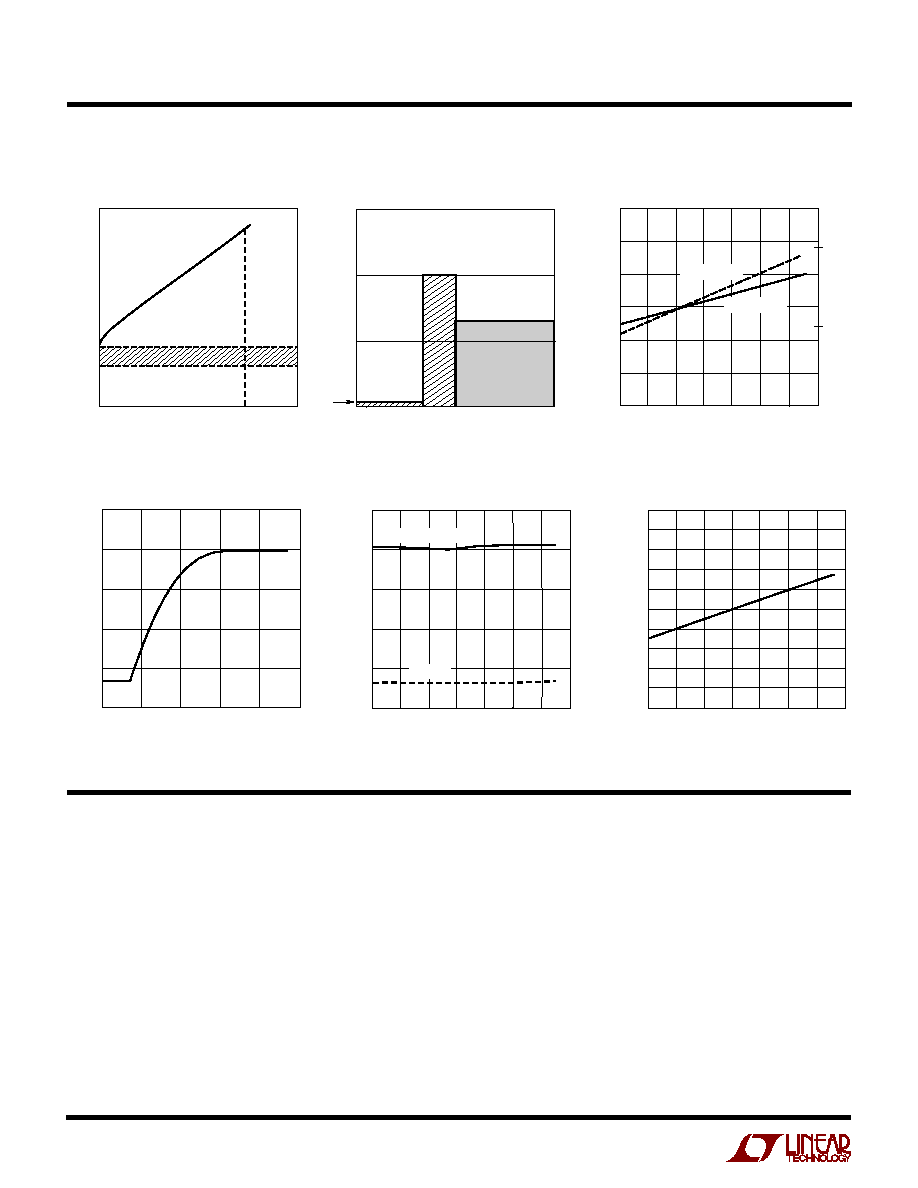
4
LTC1624
TYPICAL PERFOR
M
A
N
CE CHARACTERISTICS
U
W
V
I
TH
/RUN (V)
1.2
0.8
2.4
0
0
I
OUT(MAX)
I
OUT
(a)
1624 G01
I
OUT(MAX)
SHUTDOWN
ACTIVE
MODE
V
ITH
vs Output Current
TEMPERATURE (
∞
C)
≠40
I
TH
/RUN PIN SOURCE CURRENT WITH V
ITH
= 1V (
µ
A)
I
TH
/RUN PIN SOURCE CURRENT WITH V
ITH
= 0V (
µ
A)
300
250
200
150
100
50
0
5
4
3
2
1
0
35
85
1624 G14
≠15
10
60
110
135
I
TH
/RUN = 1V
I
TH
/RUN = 0V
I
TH
/RUN Pin Source Current vs
Temperature
I
ITH
vs V
ITH
I
I
TH
(
µ
A)
200
150
50
0
3
V
ITH
(V)
1.2
2.4
0.8
0
(b)
1624 G02
SHUTDOWN
ACTIVE
MODE
Frequency vs Feedback Voltage
FEEDBACK VOLTAGE
0
FREQUENCY (kHz)
250
200
150
100
50
0
1.00
1624 G03
0.25
0.50
0.75
1.25
TEMPERATURE (
∞
C)
≠40
CURRENT SENSE THRESHOLD (mV)
170
168
166
164
162
160
158
156
154
152
150
10
60
85
1448 G13
≠15
35
110
135
Maximum Current Sense
Threshold vs Temperature
TEMPERATURE (
∞
C)
≠40
FREQUENCY (kHz)
250
200
150
100
50
0
10
60
85
1448 G12
≠15
35
110
135
V
OUT
IN REGULATION
V
FB
= 0V
PI
N
FU
N
CTIO
N
S
U
U
U
SENSE
≠
(Pin 1): Connects to the (≠) input for the current
comparator. Built-in offsets between the SENSE
≠
and V
IN
pins in conjunction with R
SENSE
set the current trip thresh-
olds. Do not pull this pin more than 15V below V
IN
or more
than 0.3V below ground.
I
TH
/RUN (Pin 2): Combination of Error Amplifier Compen-
sation Point and Run Control Inputs. The current com-
parator threshold increases with this control voltage.
Nominal voltage range for this pin is 1.19V to 2.4V. Forcing
this pin below 0.8V causes the device to be shut down. In
shutdown all functions are disabled and TG pin is held low.
V
FB
(Pin 3): Receives the feedback voltage from an exter-
nal resistive divider across the output.
GND (Pin 4): Ground. Connect to the (≠) terminal of C
OUT
,
the Schottky diode and the (≠) terminal of C
IN
.
SW (Pin 5): Switch Node Connection to Inductor. In step-
down applications the voltage swing at this pin is from a
Schottky diode (external) voltage drop below ground to
V
IN
.
Operating Frequency vs
Temperature

5
LTC1624
TG (Pin 6): High Current Gate Drive for Top N-Channel
MOSFET. This is the output of a floating driver with a
voltage swing equal to INTV
CC
superimposed on the
switch node voltage SW.
BOOST (Pin 7): Supply to Topside Floating Driver. The
bootstrap capacitor C
B
is returned to this pin. Voltage
swing at this pin is from INTV
CC
to V
IN
+ INTV
CC
in step-
down applications. In non step-down topologies the volt-
age at this pin is constant and equal to INTV
CC
if SW = 0V.
V
IN
(Pin 8): Main Supply Pin and the (+) Input to the
Current Comparator. Must be closely decoupled to ground.
PI
N
FU
N
CTIO
N
S
U
U
U
(Refer to Functional Diagram)
OPERATIO
U
Main Control Loop
The LTC1624 uses a constant frequency, current mode
architecture. During normal operation, the top MOSFET is
turned on each cycle when the oscillator sets the RS latch
and turned off when the main current comparator I
1
resets
the RS latch. The peak inductor current at which I
1
resets
the RS latch is controlled by the voltage on the I
TH
/RUN
pin, which is the output of error amplifier EA. The V
FB
pin,
described in the pin functions, allows EA to receive an
output feedback voltage from an external resistive divider.
When the load current increases, it causes a slight
decrease in V
FB
relative to the 1.19V reference, which in
turn causes the I
TH
/RUN voltage to increase until the
average inductor current matches the new load current.
While the top MOSFET is off, the internal bottom MOSFET
is turned on for approximately 300ns to 400ns to recharge
the bootstrap capacitor C
B
.
The top MOSFET driver is biased from the floating boot-
strap capacitor C
B
that is recharged during each off cycle.
The dropout detector counts the number of oscillator
cycles that the top MOSFET remains on and periodically
forces a brief off period to allow C
B
to recharge.
The main control loop is shut down by pulling the I
TH
/RUN
pin below its 1.19V clamp voltage. Releasing I
TH
/RUN
allows an internal 2.5
µ
A current source to charge com-
pensation capacitor C
C
. When the I
TH
/ RUN pin voltage
reaches 0.8V the main control loop is enabled with the I
TH
/
RUN voltage pulled up by the error amp. Soft start can be
implemented by ramping the voltage on the I
TH
/RUN pin
from 1.19V to its 2.4V maximum (see Applications Infor-
mation section).
Comparator OV guards against transient output over-
shoots >7.5% by turning off the top MOSFET and keeping
it off until the fault is removed.
Low Current Operation
The LTC1624 is capable of Burst Mode operation in which
the external MOSFET operates intermittently based on
load demand. The transition to low current operation
begins when comparator B detects when the I
TH
/RUN
voltage is below 1.5V. If the voltage across R
SENSE
does
not exceed the offset of I
2
(approximately 20mV) for one
full cycle, then on following cycles the top and internal
bottom drives are disabled. This continues until the I
TH
voltage exceeds 1.5V, which causes drive to be returned to
the TG pin on the next cycle.
INTV
CC
Power/Boost Supply
Power for the top and internal bottom MOSFET drivers is
derived from V
IN
. An internal regulator supplies INTV
CC
power. To power the top driver in step-down applications
an internal high voltage diode recharges the bootstrap
capacitor C
B
during each off cycle from the INTV
CC
supply.
A small internal N-channel MOSFET pulls the switch node
(SW) to ground each cycle after the top MOSFET has
turned off ensuring the bootstrap capacitor is kept fully
charged.
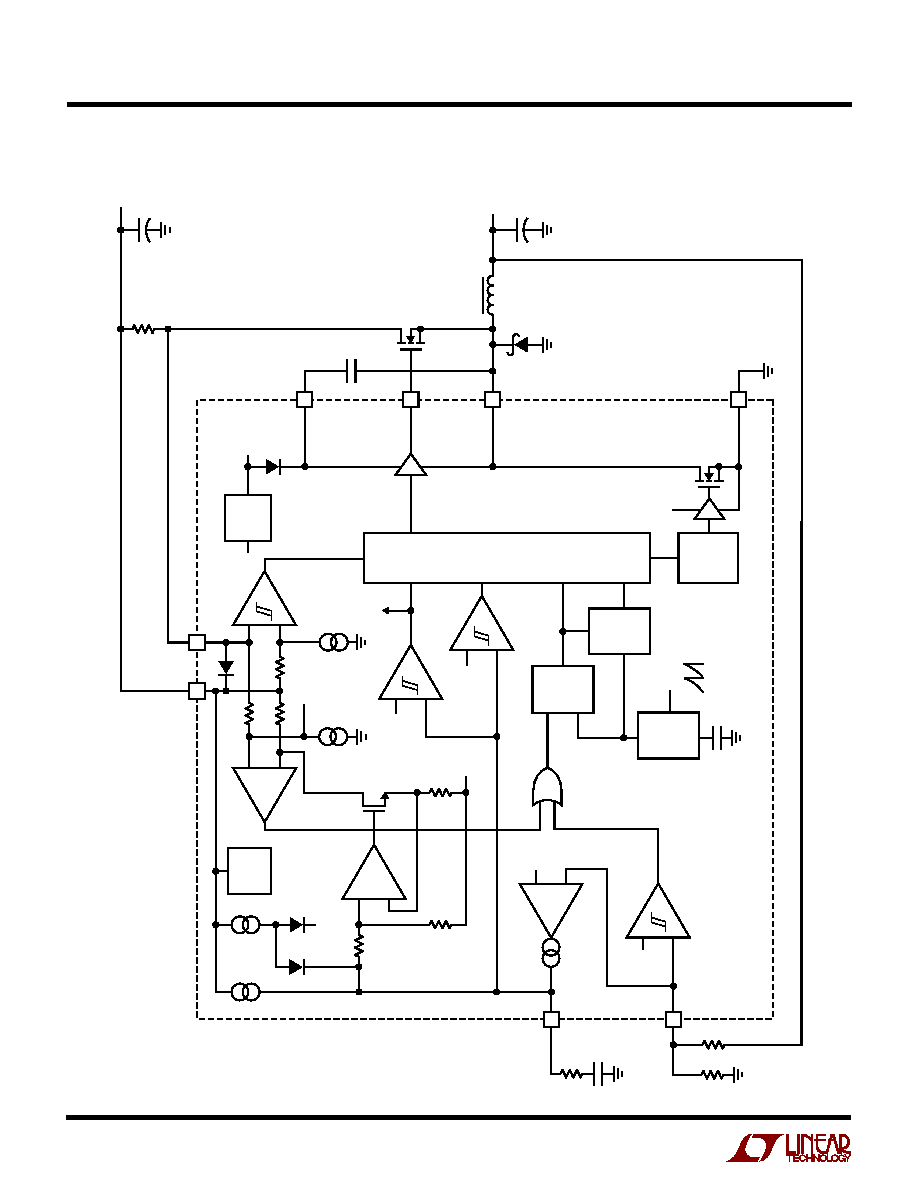
6
LTC1624
FU
N
CTIO
N
AL DIAGRA
U
U
W
(Shown in a step-down application)
≠
+
≠
+
≠
+
≠
+
+
+
≠
+
≠
+
I
2
I
1
8
4k
8k
4k
V
IN
3
µ
A
RUN
C
B
V
OUT
C
OUT
C
IN
V
IN
BOOST
FLOATING
DRIVER
TG
SW
D1
L1
N-CHANNEL
MOSFET
N-CHANNEL
MOSFET
INTV
CC
R
SENSE
SENSE
≠
D
B
5.6V
INTV
CC
REG
V
IN
0.8V
1.19V
200kHz
200kHz
1.19V
I
TH
/RUN
1.28V
1.19V
180k
1.5V
3
µ
A
30k
8k
2
3
4
5
6
7
GND
1624 FD
2.5
µ
A
SLOPE
COMP
SLOPE
COMP
ST
≠
+
B
R
S
Q
OV
OSC
DROP-
OUT
DET
1-SHOT
400ns
SWITCH
LOGIC
INTV
CC
V
FB
V
FB
R2
R1
R
C
C
C
C
OSC
EA
1
g
m
= 1m
1.19V
REF

7
LTC1624
APPLICATIO
N
S I
N
FOR
M
ATIO
N
W
U
U
U
The LTC1624 can be used in a wide variety of switching
regulator applications, the most common being the step-
down converter. Other switching regulator architectures
include step-up, SEPIC and positive-to-negative converters.
The basic LTC1624 step-down application circuit is shown
in Figure 1 on the first page. External component selection
is driven by the load requirement and begins with the
selection of R
SENSE
. Once R
SENSE
is known, the inductor
can be chosen. Next, the power MOSFET and D1 are
selected. Finally, C
IN
and C
OUT
are selected. The circuit
shown in Figure 1 can be configured for operation up to an
input voltage of 28V (limited by the external MOSFETs).
Step-Down Converter: R
SENSE
Selection for
Output Current
R
SENSE
is chosen based on the required output current.
The LTC1624 current comparator has a maximum thresh-
old of 160mV/R
SENSE
. The current comparator threshold
sets the peak of the inductor current, yielding a maximum
average output current I
MAX
equal to the peak value less
half the peak-to-peak ripple current,
I
L
.
Allowing a margin for variations in the LTC1624 and
external component values yields:
R
mV
I
SENSE
MAX
=
100
The LTC1624 works well with values of R
SENSE
from
0.005
to 0.5
.
Step-Down Converter: Inductor Value Calculation
With the operating frequency fixed at 200kHz smaller
inductor values are favored. Operating at higher frequen-
cies generally results in lower efficiency because of
MOSFET gate charge losses. In addition to this basic
trade-off, the effect of inductor value on ripple current and
low current operation must also be considered.
The inductor value has a direct effect on ripple current. The
inductor ripple current
I
L
decreases with higher induc-
tance and increases with higher V
IN
or V
OUT
:
I
V
V
f L
V
V
V
V
L
IN
OUT
OUT
D
IN
D
=
-
( )( )
+
+
where V
D
is the output Schottky diode forward drop.
Accepting larger values of
I
L
allows the use of low
inductances, but results in higher output voltage ripple
and greater core losses. A reasonable starting point for
setting ripple current is
I
L
= 0.4(I
MAX
). Remember, the
maximum
I
L
occurs at the maximum input voltage.
The inductor value also has an effect on low current
operation. Lower inductor values (higher
I
L
) will cause
Burst Mode operation to begin at higher load currents,
which can cause a dip in efficiency in the upper range of
low current operation. In Burst Mode operation lower
inductance values will cause the burst frequency to
decrease. In general, inductor values from 5
µ
H to 68
µ
H
are typical depending on the maximum input voltage and
output current. See also Modifying Burst Mode Operation
section.
Step-Down Converter: Inductor Core Selection
Once the value for L is known, the type of inductor must be
selected. High efficiency converters generally cannot
afford the core loss found in low cost powdered iron cores,
forcing the use of more expensive ferrite, molypermalloy
or Kool M
µ
Æ
cores. Actual core loss is independent of core
size for a fixed inductor value, but it is very dependent on
inductance selected. As inductance increases, core losses
go down. Unfortunately, increased inductance requires
more turns of wire and, therefore, copper losses will
increase.
Ferrite designs have very low core loss and are preferred
at high switching frequencies, so design goals can con-
centrate on copper loss and preventing saturation. Ferrite
core material saturates "hard," which means that induc-
tance collapses abruptly when the peak design current is
exceeded. This results in an abrupt increase in inductor
ripple current and consequent output voltage ripple. Do
not allow the core to saturate!
Molypermalloy (from Magnetics, Inc.) is a very good, low
loss core material for toroids, but it is more expensive than
ferrite. A reasonable compromise from the same manu-
facturer is Kool M
µ
. Toroids are very space efficient,
especially when you can use several layers of wire.
Because they generally lack a bobbin, mounting is more
difficult. However, designs for surface mount that do not
increase the height significantly are available.
Kool Mu is a registered trademark of Magnetics, Inc.
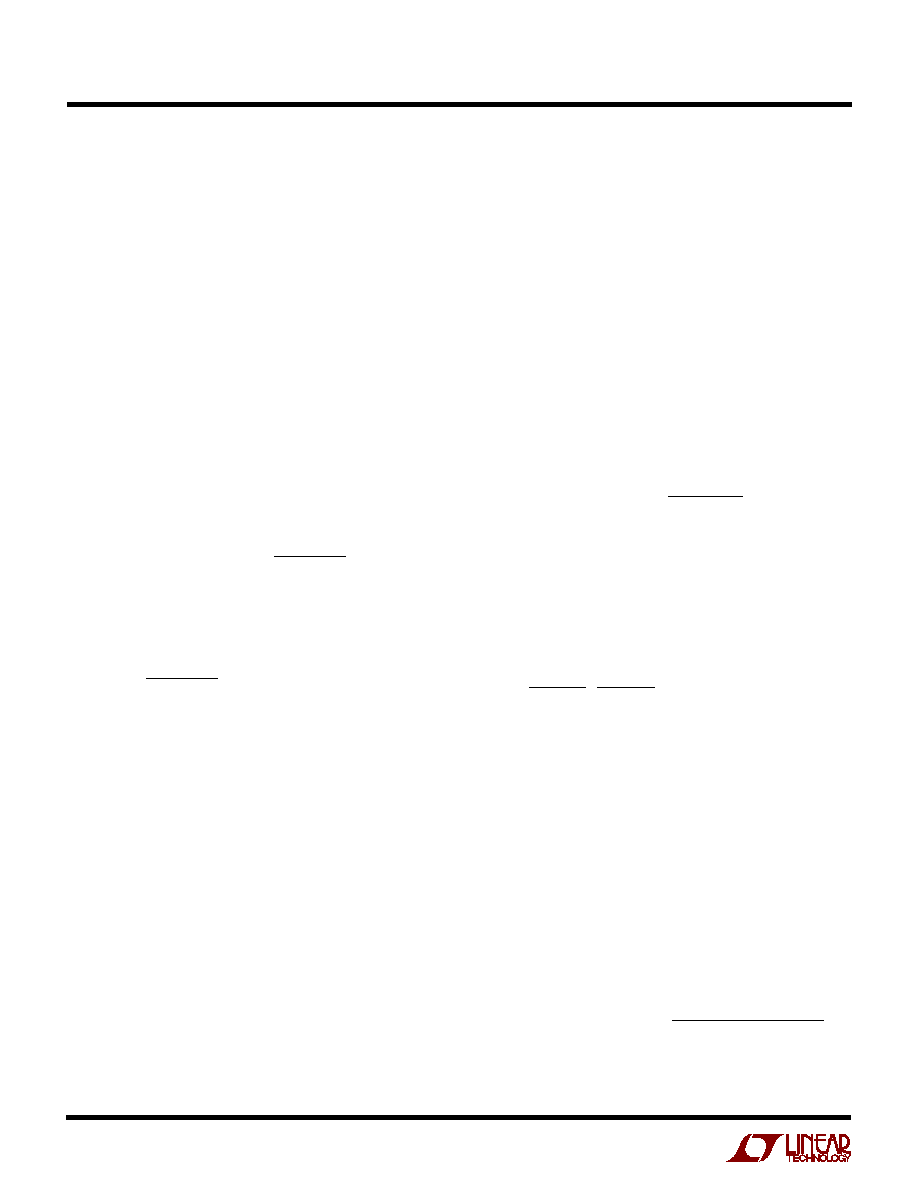
8
LTC1624
Step-Down Converter: Power MOSFET Selection
One external N-channel power MOSFET must be selected
for use with the LTC1624 for the top (main) switch.
The peak-to-peak gate drive levels are set by the INTV
CC
voltage. This voltage is typically 5V. Consequently, logic
level threshold MOSFETs must be used in most LTC1624
applications. If low input voltage operation is expected
(V
IN
< 5V) sublogic level threshold MOSFETs should be
used. Pay close attention to the BV
DSS
specification for the
MOSFETs as well; many of the logic level MOSFETs are
limited to 30V or less.
Selection criteria for the power MOSFET include the "ON"
resistance R
DS(ON)
, reverse transfer capacitance C
RSS
,
input voltage and maximum output current. When the
LTC1624 is operating in continuous mode the duty cycle
for the top MOSFET is given by:
Main
V
V
V
D
IN
D
Switch Duty Cycle =
V
OUT
+
+
The MOSFET power dissipation at maximum output
current is given by:
P
V
V
V
V
I
k V
I
C
f
MAIN
OUT
D
IN
D
MAX
IN
MAX
RSS
=
+
+
( )
+
( )
+
( ) ( )( )( )
( )
2
1 85
1
R
DS ON
.
where
is the temperature dependency of R
DS(ON)
and k
is a constant inversely related to the gate drive current.
MOSFETs have I
2
R losses, plus the P
MAIN
equation
includes an additional term for transition losses that are
highest at high output voltages. For V
IN
< 20V the high
current efficiency generally improves with larger MOSFETs,
while for V
IN
> 20V the transition losses rapidly increase to
the point that the use of a higher R
DS(ON)
device with lower
C
RSS
actual provides higher efficiency. The diode losses
are greatest at high input voltage or during a short circuit
when the diode duty cycle is nearly 100%.
The term (1+
) is generally given for a MOSFET in the form
of a normalized R
DS(ON)
vs Temperature curve, but
= 0.005/
∞
C can be used as an approximation for low
voltage MOSFETs. C
RSS
is usually specified in the MOSFET
APPLICATIO
N
S I
N
FOR
M
ATIO
N
W
U
U
U
characteristics. The constant k = 2.5 can be used to
estimate the contributions of the two terms in the P
MAIN
dissipation equation.
Step-Down Converter: Output Diode Selection (D1)
The Schottky diode D1 shown in Figure 1 conducts during
the off-time. It is important to adequately specify the diode
peak current and average power dissipation so as not to
exceed the diode ratings.
The most stressful condition for the output diode is under
short circuit (V
OUT
= 0V). Under this condition, the diode
must safely handle I
SC(PK)
at close to 100% duty cycle.
Under normal load conditions, the average current con-
ducted by the diode is simply:
I
I
V
V
V
V
DIODE AVG
LOAD AVG
IN
OUT
IN
D
( )
( )
=
-
+
Remember to keep lead lengths short and observe proper
grounding (see Board Layout Checklist) to avoid ringing
and increased dissipation.
The forward voltage drop allowable in the diode is calcu-
lated from the maximum short-circuit current as:
V
P
I
V
V
V
D
D
SC AVG
IN
D
IN
+
( )
where P
D
is the allowable diode power dissipation and will
be determined by efficiency and/or thermal requirements
(see Efficiency Considerations).
Step-Down Converter: C
IN
and C
OUT
Selection
In continuous mode the source current of the top
N-channel MOSFET is a square wave of approximate duty
cycle V
OUT
/V
IN
. To prevent large voltage transients, a low
ESR input capacitor sized for the maximum RMS current
must be used. The maximum RMS capacitor current is
given by:
C
I
V
V
V
V
IN
MAX
OUT
IN
OUT
IN
Required I
RMS
-
(
)
[
]
1 2
/
This formula has a maximum at V
IN
= 2V
OUT
, where
I
RMS
= I
OUT
/2. This simple worst-case condition is com-

9
LTC1624
APPLICATIO
N
S I
N
FOR
M
ATIO
N
W
U
U
U
ratings that are ideal for input capacitor applications.
Consult the manufacturer for other specific recommend-
ations.
INTV
CC
Regulator
An internal regulator produces the 5V supply that powers
the drivers and internal circuitry within the LTC1624.
Good V
IN
bypassing is necessary to supply the high
transient currents required by the MOSFET gate drivers.
High input voltage applications in which large MOSFETs
are being driven at high frequencies may cause the maxi-
mum junction temperature rating for the LTC1624 to be
exceeded. The supply current is dominated by the gate
charge supply current as discussed in the Efficiency
Considerations section. The junction temperature can be
estimated by using the equations given in Note 1 of the
Electrical Characteristics table. For example, the LTC1624
is limited to less than 17mA from a 30V supply:
T
J
= 70
∞
C + (17mA)(30V)(110
∞
C/W) = 126
∞
C
To prevent maximum junction temperature from being
exceeded, the input supply current must be checked
operating in continuous mode at maximum V
IN
.
Step-Down Converter: Topside MOSFET Driver
Supply (C
B
, D
B
)
An external bootstrap capacitor C
B
connected to the BOOST
pin supplies the gate drive voltage for the topside MOSFET.
Capacitor C
B
in the functional diagram is charged through
internal diode D
B
from INTV
CC
when the SW pin is low.
When the topside MOSFET is to be turned on, the driver
places the C
B
voltage across the gate to source of the
MOSFET. This enhances the MOSFET and turns on the
topside switch. The switch node voltage SW rises to V
IN
and the BOOST pin rises to V
IN
+ INTV
CC
. The value of the
boost capacitor C
B
needs to be 50 times greater than the
total input capacitance of the topside MOSFET. In most
applications 0.1
µ
F is adequate.
Significant efficiency gains can be realized by supplying
topside driver operating voltage from the output, since the
V
IN
current resulting from the driver and control currents
will be scaled by a factor of (Duty Cycle)/(Efficiency). For
5V regulators this simply means connecting the BOOST
monly used for design because even significant deviations
do not offer much relief. Note that capacitor manufacturer's
ripple current ratings are often based on only 2000 hours
of life. This makes it advisable to further derate the
capacitor, or to choose a capacitor rated at a higher
temperature than required. Several capacitors may also be
paralleled to meet size or height requirements in the
design. Always consult the manufacturer if there is any
question.
The selection of C
OUT
is driven by the required effective
series resistance (ESR). Typically, once the ESR require-
ment is satisfied the capacitance is adequate for filtering.
The output ripple (
V
OUT
) is determined by:
V
I ESR
fC
OUT
L
OUT
+
1
4
where f = operating frequency, C
OUT
= output capacitance
and
I
L
= ripple current in the inductor. The output ripple
is highest at maximum input voltage since
I
L
increases
with input voltage. With
I
L
= 0.4I
OUT(MAX)
the output
ripple will be less than 100mV at maximum V
IN
, assuming:
C
OUT
Required ESR < 2R
SENSE
Manufacturers such as Nichicon, United Chemicon and
SANYO should be considered for high performance
through-hole capacitors. The OS-CON semiconductor
dielectric capacitor available from SANYO has the lowest
ESR(size) product of any aluminum electrolytic at a some-
what higher price. Once the ESR requirement for C
OUT
has
been met, the RMS current rating generally far exceeds
the I
RIPPLE(P-P)
requirement.
In surface mount applications multiple capacitors may
have to be paralleled to meet the ESR or RMS current
handling requirements of the application. Aluminum elec-
trolytic and dry tantalum capacitors are both available in
surface mount configurations. In the case of tantalum it is
critical that the capacitors are surge tested for use in
switching power supplies. An excellent choice is the AVX
TPS series of surface mount tantalums, available in case
heights ranging from 2mm to 4mm. Other capacitor types
include SANYO OS-CON, Nichicon WF series and Sprague
595D series and the new ceramics. Ceramic capacitors are
now available in extremely low ESR and high ripple current
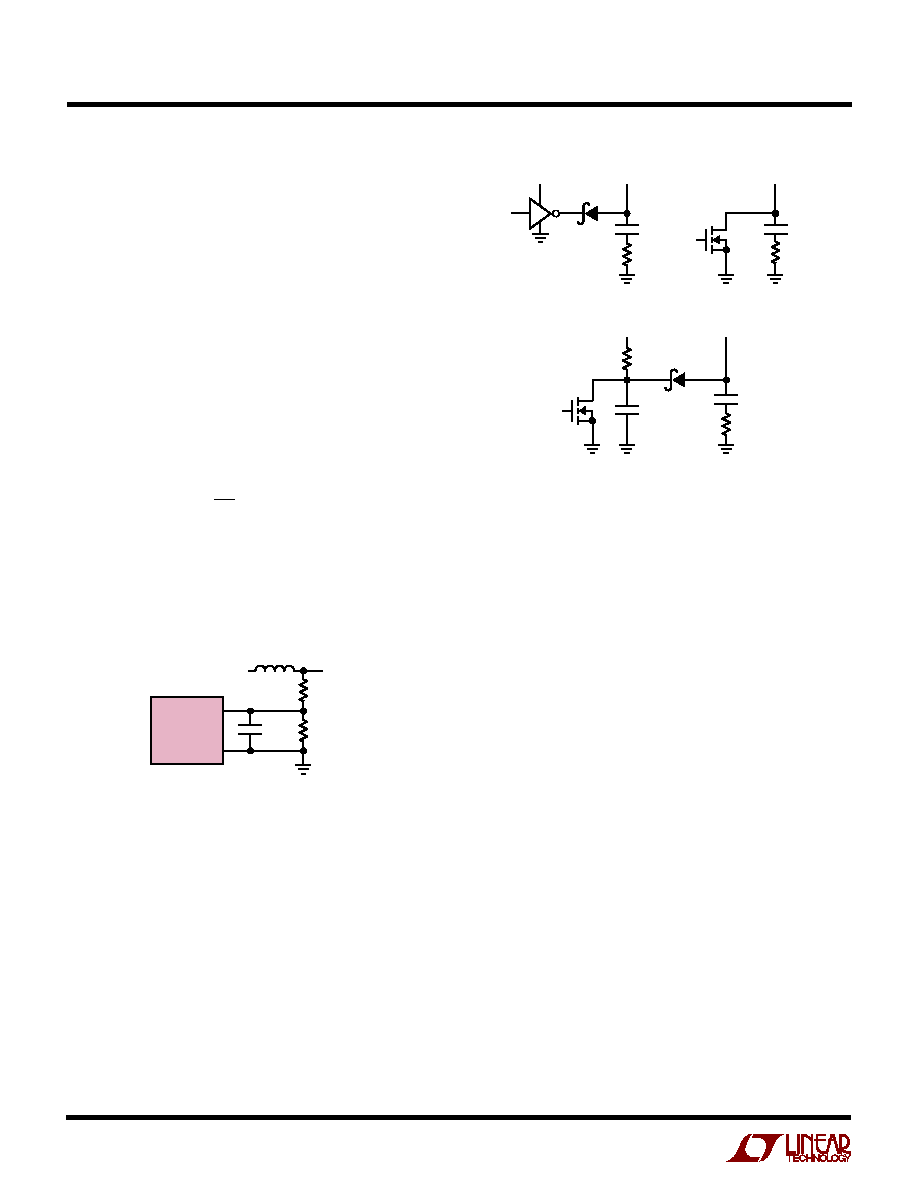
10
LTC1624
pin through a small Schottky diode (like a Central
CMDSH-3) to V
OUT
as shown in Figure 10. However, for
3.3V and other lower voltage regulators, additional cir-
cuitry is required to derive boost supply power from the
output.
For low input voltage operation (V
IN
< 7V), a Schottky
diode can be connected from V
IN
to BOOST to increase the
external MOSFET gate drive voltage. Be careful not to
exceed the maximum voltage on BOOST to SW pins
of 7.8V.
Output Voltage Programming
The output voltage is set by a resistive divider according
to the following formula:
V
V
R
R
OUT
=
+
1 19
1
2
1
.
The external resistive divider is connected to the output as
shown in Figure 2, allowing remote voltage sensing. When
using remote sensing, a local 100
resistor should be
connected from L1 to R2 to prevent V
OUT
from running
away if the sense lead is disconnected.
APPLICATIO
N
S I
N
FOR
M
ATIO
N
W
U
U
U
I
TH
/RUN
C
C
R
C
1624 F03
D1
3.3V
OR 5V
I
TH
/RUN
C
C
R
C
(a)
(b)
D1
C1
R1
I
TH
/RUN
C
C
R
C
(c)
Figure 3. I
TH
/ RUN Pin Interfacing
Soft start can be implemented by ramping the voltage on
I
TH
/RUN during start-up as shown in Figure 3(c). As the
voltage on I
TH/RUN
ramps from 1.19V to 2.4V the internal
peak current limit is also ramped at a proportional linear
rate. The peak current limit begins at approximately
10mV/R
SENSE
(at V
ITH/RUN
= 1.4V) and ends at:
160mV/R
SENSE
(V
ITH/RUN
= 2.4V)
The output current thus ramps up slowly, charging the
output capacitor. The peak inductor current and maximum
output current are as follows:
I
L(PEAK)
= (V
ITH/RUN
≠ 1.3V)/(6.8R
SENSE
)
I
OUT(MAX)
= I
LPEAK
≠
I
L
/ 2
with
I
L
= ripple current in the inductor.
During normal operation the voltage on the I
TH
/RUN pin
will vary from 1.19V to 2.4V depending on the load current.
Pulling the I
TH
/RUN pin below 0.8V puts the LTC1624 into
a low quiescent current shutdown (I
Q
< 30
µ
A). This pin can
be driven directly from logic as shown in Figures 3(a)
and 3(b).
Efficiency Considerations
The percent efficiency of a switching regulator is equal to
the output power divided by the input power times 100%.
It is often useful to analyze individual losses to determine
I
TH
/RUN Function
The I
TH
/RUN pin is a dual purpose pin that provides the
loop compensation and a means to shut down the LTC1624.
Soft start can also be implemented with this pin. Soft start
reduces surge currents from V
IN
by gradually increasing
the internal current limit.
Power supply sequencing can
also be accomplished using this pin.
An internal 2.5
µ
A current source charges up the external
capacitor C
C.
When the voltage on I
TH
/RUN reaches 0.8V
the LTC1624 begins operating. At this point the error
amplifier pulls up the I
TH
/RUN pin to its maximum of 2.4V
(assuming V
OUT
is starting low).
Figure 2. Setting the LTC1624 Output Voltage
LTC1624
V
FB
GND
100pF
R2
L1
R1
V
OUT
1624 F02

11
LTC1624
what is limiting the efficiency and which change would
produce the most improvement. Percent efficiency can be
expressed as:
%Efficiency = 100% ≠ (L1 + L2 + L3 + ...)
where L1, L2, etc. are the individual losses as a percentage
of input power.
Although all dissipative elements in the circuit produce
losses, four main sources usually account for most of the
losses in LTC1624 circuits:
1. LTC1624 V
IN
current
2. I
2
R losses
3. Topside MOSFET transition losses
4. Voltage drop of the Schottky diode
1. The V
IN
current is the sum of the DC supply current I
Q
,
given in the Electrical Characteristics table, and the
MOSFET driver and control currents. The MOSFET
driver current results from switching the gate
capacitance of the power MOSFET. Each time a MOSFET
gate is switched from low to high to low again, a packet
of charge dQ moves from INTV
CC
to ground. The
resulting dQ/dt is a current out of V
IN
which is typically
much larger than the control circuit current. In
continuous mode, I
GATECHG
= f (Q
T
+ Q
B
), where Q
T
and
Q
B
are the gate charges of the topside and internal
bottom side MOSFETs.
By powering BOOST from an output-derived source
(Figure 10 application), the additional V
IN
current
resulting from the topside driver will be scaled by a
factor of (Duty Cycle)/(Efficiency). For example, in a
20V to 5V application, 5mA of INTV
CC
current results in
approximately 1.5mA of V
IN
current. This reduces the
midcurrent loss from 5% or more (if the driver was
powered directly from V
IN
) to only a few percent.
2. I
2
R losses are predicted from the DC resistances of the
MOSFET, inductor and current shunt. In continuous
mode the average output current flows through L but is
"chopped" between the topside main MOSFET/current
shunt and the Schottky diode. The resistances of the
topside MOSFET and R
SENSE
multiplied by the duty
cycle can simply be summed with the resistance of L to
obtain I
2
R losses. (Power is dissipated in the sense
resistor only when the topside MOSFET is on. The I
2
R
loss is thus reduced by the duty cycle.) For example, at
50% DC, if R
DS(ON)
= 0.05
, R
L
= 0.15
and R
SENSE
=
0.05
, then the effective total resistance is 0.2
. This
results in losses ranging from 2% to 8% for V
OUT
= 5V
as the output current increases from 0.5A to 2A. I
2
R
losses cause the efficiency to drop at high output
currents.
3. Transition losses apply only to the topside MOSFET(s),
and only when operating at high input voltages (typically
20V or greater). Transition losses can be estimated
from:
Transition Loss = 2.5(V
IN
)
1.85
(I
MAX
)(C
RSS
)(f)
4. The Schottky diode is a major source of power loss at
high currents and gets worse at high input voltages.
The diode loss is calculated by multiplying the forward
voltage drop times the diode duty cycle multiplied by
the load current. For example, assuming a duty cycle of
50% with a Schottky diode forward voltage drop of
0.5V, the loss is a relatively constant 5%.
As expected, the I
2
R losses and Schottky diode loss
dominate at high load currents. Other losses including
C
IN
and C
OUT
ESR dissipative losses and inductor core
losses generally account for less than 2% total additional
loss.
Checking Transient Response
The regulator loop response can be checked by looking at
the load transient response. Switching regulators take
several cycles to respond to a step in DC (resistive) load
current. When a load step occurs, V
OUT
immediately shifts
by an amount equal to (
I
LOAD
∑ ESR), where ESR is the
effective series resistance of C
OUT
.
I
LOAD
also begins to
charge or discharge C
OUT
which generates a feedback
error signal. The regulator loop then acts to return V
OUT
to
its steady-state value. During this recovery time V
OUT
can
be monitored for overshoot or ringing that would indicate
a stability problem. The I
TH
external components shown in
the Figure 1 circuit will provide adequate compensation for
most applications.
A second, more severe transient, is caused by switching in
loads with large (>1
µ
F) supply bypass capacitors. The
discharged bypass capacitors are effectively put in parallel
APPLICATIO
N
S I
N
FOR
M
ATIO
N
W
U
U
U
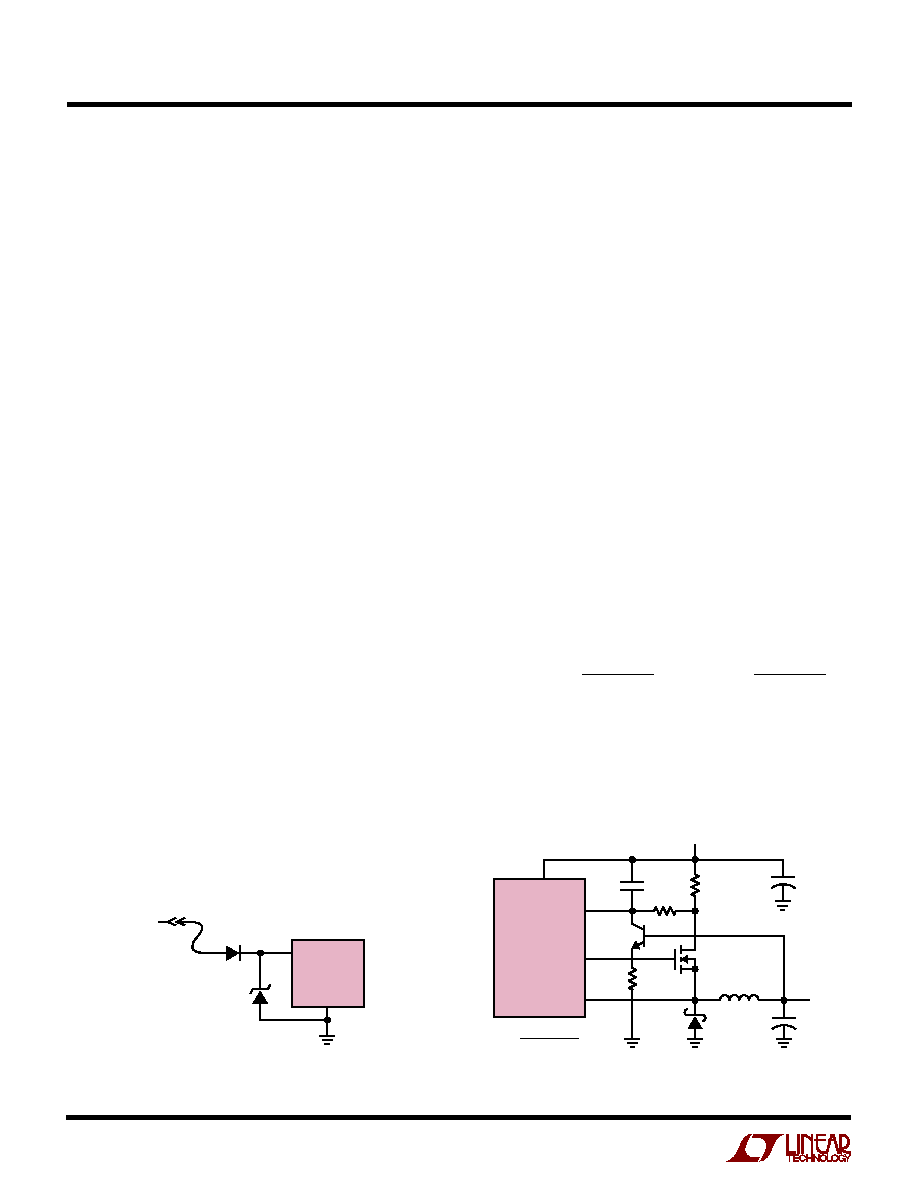
12
LTC1624
with C
OUT
, causing a rapid drop in V
OUT
. No regulator can
deliver enough current to prevent this problem if the load
switch resistance is low and it is driven quickly. The only
solution is to limit the rise time of the switch drive so that
the load rise time is limited to approximately (25 ∑ C
LOAD
).
Thus a 10
µ
F capacitor would require a 250
µ
s rise time,
limiting the charging current to about 200mA.
Automotive Considerations: Plugging into the
Cigarette Lighter
As battery-powered devices go mobile there is a natural
interest in plugging into the cigarette lighter in order to
conserve or even recharge battery packs during operation.
But before you connect, be advised: you are plugging into
the supply from hell. The main battery line in an automo-
bile is the source of a number of nasty potential transients,
including load dump, reverse battery and double battery.
Load dump is the result of a loose battery cable. When the
cable breaks connection, the field collapse in the alternator
can cause a positive spike as high as 60V which takes
several hundred milliseconds to decay. Reverse battery is
just what it says, while double battery is a consequence of
tow-truck operators finding that a 24V jump start cranks
cold engines faster than 12V.
The network shown in Figure 4 is the most straightforward
approach to protect a DC/DC converter from the ravages
of an automotive battery line. The series diode prevents
current from flowing during reverse battery, while the
transient suppressor clamps the input voltage during load
dump. Note that the transient suppressor should not
conduct during double battery operation, but must still
clamp the input voltage below breakdown of the converter.
Although the LTC1624 has a maximum input voltage of
APPLICATIO
N
S I
N
FOR
M
ATIO
N
W
U
U
U
36V, most applications will be limited to 30V by the
MOSFET BV
DSS
.
Modifying Burst Mode Operation
The LTC1624 automatically enters Burst Mode operation
at low output currents to boost efficiency. The point when
continuous mode operation changes to Burst Mode op-
eration scales as a function of maximum output current.
The output current when Burst Mode operation com-
mences is approximately 8mV/R
SENSE
(8% of maximum
output current).
With the additional circuitry shown in Figure 5 the LTC1624
can be forced to stay in continuous mode longer at low
output currents. Since the LTC1624 is not a fully synchro-
nous architecture, it will eventually start to skip cycles as
the load current drops low enough. The point when the
minimum on-time (450ns) is reached determines the load
current when cycle skipping begins at approximately 1%
of maximum output current. Using the circuit in Figure 5
the LTC1624 will begin to skip cycles but stays in regula-
tion when I
OUT
is less than I
OUT(MIN)
:
I
t
f
L
V
V
V
V
V
V
OUT MIN
ON MIN
IN
OUT
IN
D
OUT
D
( )
( )
=
-
(
)
+
+
2
2
where t
ON(MIN)
= 450ns, f = 200kHz.
The transistor Q1 in the circuit of Figure 5 operates as a
current source developing an 18mV offset across the
+
+
1000pF
100
18mV
R*
C
OUT
L1
R
SENSE
C
IN
V
OUT
D1
MBRS340T3
Q1
2N2222
V
IN
1624 F05
(V
OUT
≠ 0.7V)
180
µ
A
*R =
V
IN
LTC1624
SENSE
≠
TG
SW
+
≠
Figure 5. Modifying Burst Mode Operation
Figure 4. Plugging into the Cigarette Lighter
LTC1624
V
IN
50A I
PK
RATING
12V
TRANSIENT VOLTAGE
SUPPRESSOR
GENERAL INSTRUMENT
1.5KA24A
1624 F04
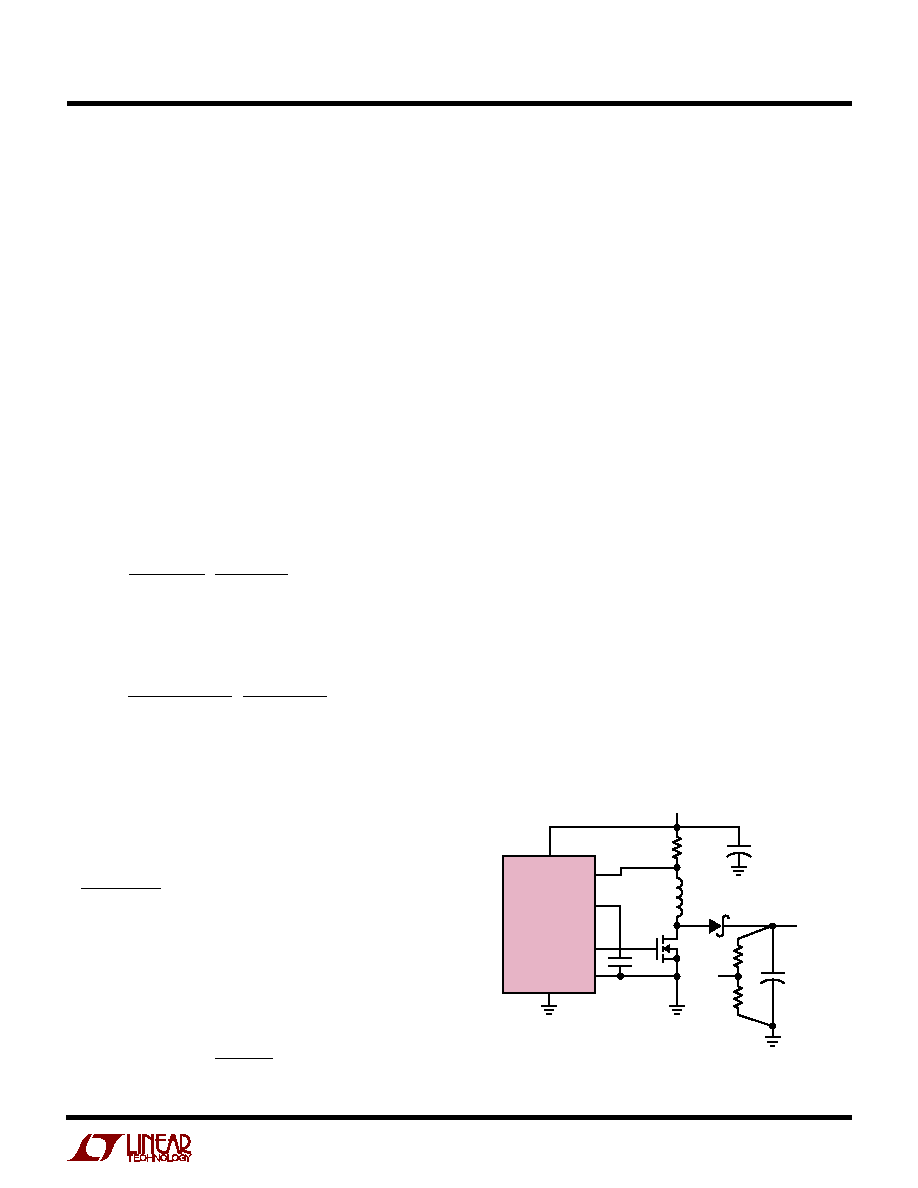
13
LTC1624
100
resistor in series with the SENSE
≠
pin. This offset
cancels the internal offset in current comparator I
2
(refer
to Functional Diagram). This comparator in conjunction
with the voltage on the I
TH
/RUN pin determines when to
enter into Burst Mode operation (refer to Low Current
Operation in Operation section). With the additional exter-
nal offset present, the drive to the topside MOSFET is
always enabled every cycle and constant frequency opera-
tion occurs for I
OUT
> I
OUT(MIN)
.
Step-Down Converter: Design Example
As a design example, assume V
IN
= 12V(nominal),
V
IN
= 22V(max), V
OUT
= 3.3V and I
MAX
= 2A. R
SENSE
can
immediately be calculated:
R
SENSE
= 100mV/2A = 0.05
Assume a 10
µ
H inductor. To check the actual value of the
ripple current the following equation is used:
I
V
V
f L
V
V
V
V
L
IN
OUT
OUT
D
IN
D
=
-
( )( )
+
+
The highest value of the ripple current occurs at the
maximum input voltage:
I
V
V
kHz
H
V
V
V
V
L
=
-
( )
+
+
=
22
3 3
200
10
3 3
0 5
22
0 5
1 58
.
.
.
.
.
µ
A
P-P
The power dissipation on the topside MOSFET can be
easily estimated. Choosing a Siliconix Si4412DY results
in: R
DS(ON)
= 0.042
, C
RSS
= 100pF. At maximum input
voltage with T(estimated) = 50
∞
C:
P
V
V
V
V
A
C
C
V
A
pF
kHz
mW
MAIN
=
+
+
( )
+
( )
∞ - ∞
(
)
[
]
(
)
+
( ) ( )( )(
)
=
3 3
0 5
22
0 5
2
1
0 005 50
25
0 042
2 5 22
2
100
200
62
2
1 85
.
.
.
.
.
.
.
The most stringent requirement for the Schottky diode
occurs when V
OUT
= 0V (i.e. short circuit) at maximum V
IN
.
In this case the worst-case dissipation rises to:
P
I
V
V
V
V
D
SC AVG
D
IN
IN
D
=
( )
+
( )
APPLICATIO
N
S I
N
FOR
M
ATIO
N
W
U
U
U
With the 0.05
sense resistor I
SC(AVG)
= 2A will result,
increasing the 0.5V Schottky diode dissipation to 0.98W.
C
IN
is chosen for an RMS current rating of at least 1.0A at
temperature. C
OUT
is chosen with an ESR of 0.03
for low
output ripple. The output ripple in continuous mode will be
highest at the maximum input voltage. The output voltage
ripple due to ESR is approximately:
V
ORIPPLE
= R
ESR
(
I
L
) = 0.03
(1.58A
P-P
) = 47mV
P-P
Step-Down Converter: Duty Cycle Limitations
At high input to output differential voltages the on-time
gets very small. Due to internal gate delays and response
times of the internal circuitry the minimum recommended
on-time is 450ns. Since the LTC1624's frequency is inter-
nally set to 200kHz a potential duty cycle limitation exists.
When the duty cycle is less than 9%, cycle skipping may
occur which increases the inductor ripple current but does
not cause V
OUT
to lose regulation. Avoiding cycle skipping
imposes a limit on the input voltage for a given output
voltage only when V
OUT
< 2.2V using 30V MOSFETs.
(Remember not to exceed the absolute maximum voltage
of 36V.)
V
IN(MAX)
= 11.1V
OUT
+ 5V For DC > 9%
Boost Converter Applications
The LTC1624 is also well-suited to boost converter appli-
cations. A boost converter steps up the input voltage to a
higher voltage as shown in Figure 6.
Figure 6. Boost Converter
+
C
B
L1
M1
R2
R1
R
SENSE
C
IN
D1
V
IN
1624 F06
V
IN
V
FB
LTC1624
SENSE
≠
BOOST
TG
SW
GND
+
C
OUT
V
OUT
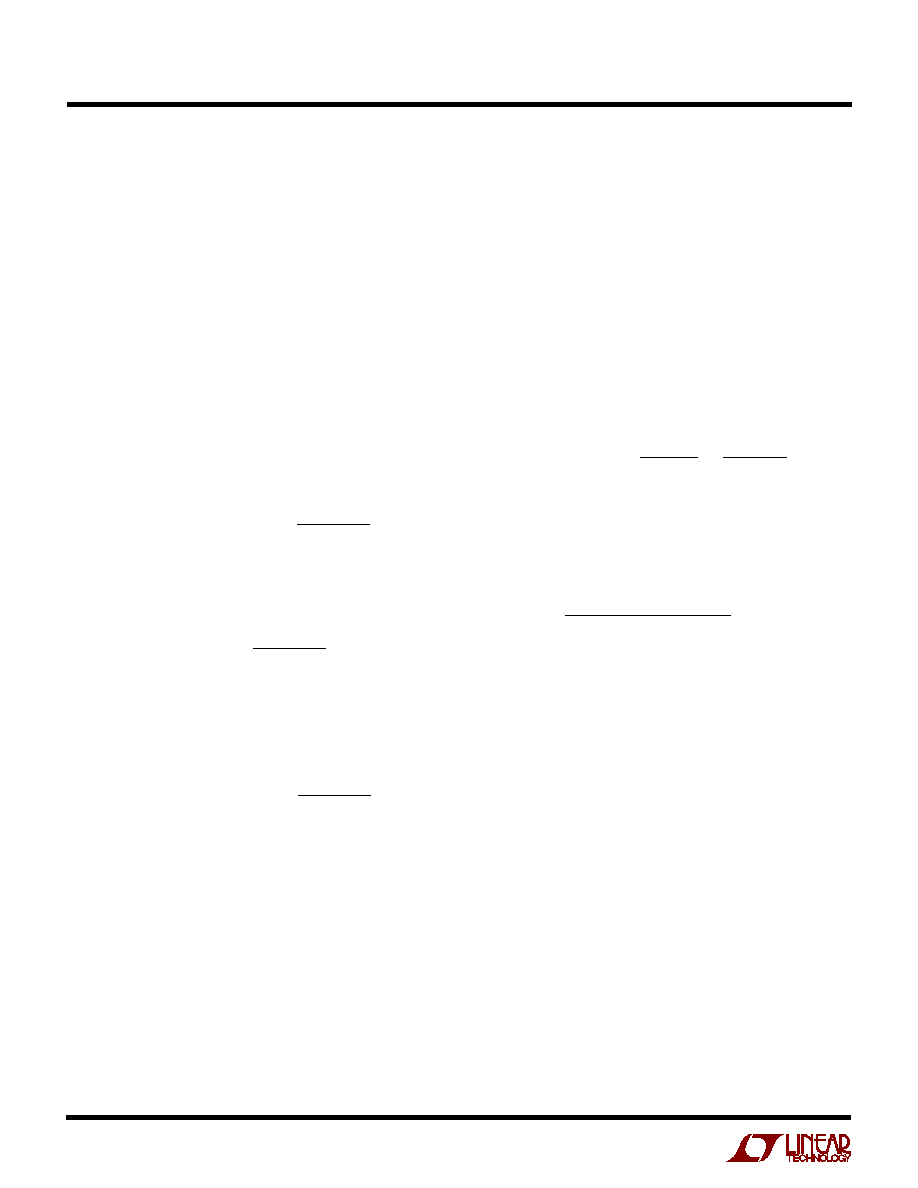
14
LTC1624
Boost Converters: Power MOSFET Selection
One external N-channel power MOSFET must be selected
for use with the LTC1624 for the switch. In boost applica-
tions the source of the power MOSFET is grounded along
with the SW pin. The peak-to-peak gate drive levels are set
by the INTV
CC
voltage. The gate drive voltage is equal to
approximately 5V for V
IN
> 5.6V and a logic level MOSFET
can be used. At V
IN
voltages below 5V the gate drive
voltage is equal to V
IN
≠ 0.6V and a sublogic level MOSFET
should be used.
Selection criteria for the power MOSFET include the "ON"
resistance R
DS(ON)
, reverse transfer capacitance C
RSS
,
input voltage and maximum output current. When the
LTC1624 is operating in continuous mode the duty cycle
for the MOSFET is given by:
Main Switch Duty Cycle = 1
-
+
V
V
V
IN
OUT
D
The MOSFET power dissipation at maximum output cur-
rent is given by:
APPLICATIO
N
S I
N
FOR
M
ATIO
N
W
U
U
U
Boost Converter: Inductor Selection
For most applications the inductor will fall in the range of
10
µ
H to 100
µ
H. Higher values reduce the input ripple
voltage and reduce core loss. Lower inductor values are
chosen to reduce physical size.
The input current of the boost converter is calculated at full
load current. Peak inductor current can be significantly
higher than output current, especially with smaller induc-
tors and lighter loads. The following formula assumes
continuous mode operation and calculates maximum peak
inductor current at minimum V
IN
:
I
I
V
V
I
L PEAK
OUT MAX
OUT
IN MIN
L MAX
( )
( ) ( )
( )
=
+
2
The ripple current in the inductor (
I
L
) is typically 20% to
30% of the peak inductor current occuring at V
IN(MIN)
and
I
OUT(MAX)
.
I
V
V
V
V
kHz L V
V
L
IN
OUT
D
IN
OUT
D
P-P
( )
=
+
-
(
)
(
)( )
+
(
)
200
with
I
L(MAX)
=
I
L(P-P)
at V
IN
= V
IN(MIN)
.
Remember boost converters are not short-circuit pro-
tected, and that under output short conditions, inductor
current is limited only by the available current of the input
supply, I
OUT(OVERLOAD)
. Specify the maximum inductor
current to safely handle the greater of I
L(PEAK)
or
I
OUT(OVERLOAD)
. Make sure the inductor's saturation cur-
rent rating (current when inductance begins to fall)
exceeds the maximum current rating set by R
SENSE
.
Boost Converter: R
SENSE
Selection for Maximum
Output Current
R
SENSE
is chosen based on the required output current.
Remember the LTC1624 current comparator has a maxi-
mum threshold of 160mV/R
SENSE
. The current compara-
tor threshold sets the peak of the inductor current, yielding
a maximum average output current I
OUT(MAX)
equal to
I
L(PEAK)
less half the peak-to-peak ripple current (
I
L
),
divided by the output-input voltage ratio (see equation for
I
L(PEAK)
)
.
P
I
V
V
V
R
k V
I
C
kHz
where
I
I
V
V
V
MAIN
IN MAX
IN MIN
OUT
D
DS ON
OUT
IN MAX
RSS
IN MAX
OUT MAX
OUT
D
IN MIN
=
-
+
+
( )
+
( )
( )(
)
=
+
( )
( )
( )
( )
( )
( )
( )
2
1 85
1
1
200
.
is the temperature dependency of R
DS(ON)
and k is a
constant inversely related to the gate drive current.
MOSFETs have I
2
R losses, plus the P
MAIN
equation
includes an additional term for transition losses that are
highest at high output voltages. For V
OUT
< 20V the high
current efficiency generally improves with larger MOSFETs,
while for V
OUT
> 20V the transition losses rapidly increase
to the point that the use of a higher R
DS(ON)
device with
lower C
RSS
actual provides higher efficiency. For addi-
tional information refer to Step-Down Converter: Power
MOSFET Selection in the Applications Information
section.
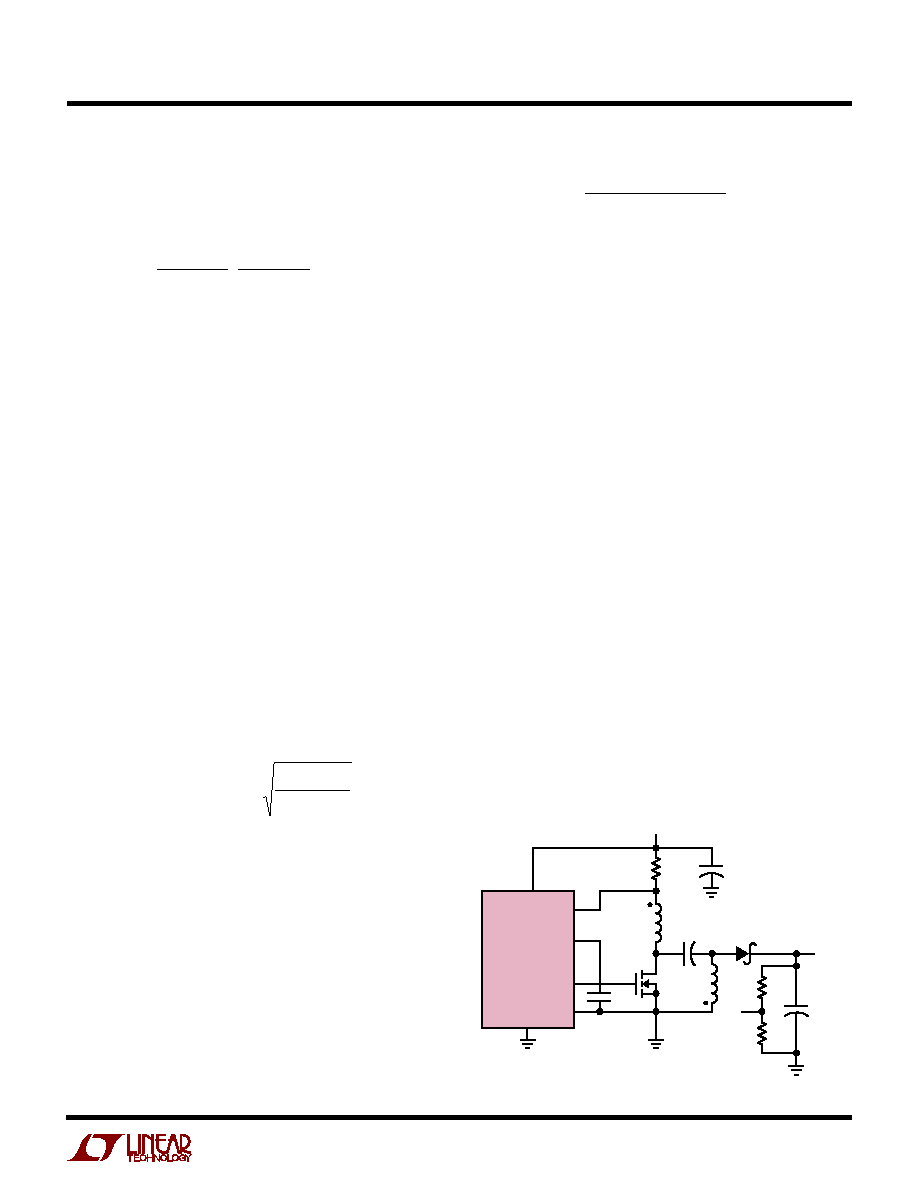
15
LTC1624
Allowing a margin for variations in the LTC1624 (without
considering variation in R
SENSE
), assuming 30% ripple
current in the inductor, yields:
R
mV
I
V
V
V
SENSE
OUT MAX
IN MIN
OUT
D
=
+
( )
( )
100
Boost Converter: Output Diode
The output diode conducts current only during the switch
off-time. Peak reverse voltage for boost converters is
equal to the regulator output voltage. Average forward
current in normal operation is equal to output current.
Remember boost converters are not short-circuit pro-
tected. Check to be sure the diode's current rating exceeds
the maximum current set by R
SENSE
. Schottky diodes such
as Motorola MBR130LT3 are recommended.
Boost Converter: Output Capacitors
The output capacitor is normally chosen by its effective
series resistance (ESR), because this is what determines
output ripple voltage.
Since the output capacitor's ESR affects efficiency, use
low ESR capacitors for best performance. Boost regula-
tors have large RMS ripple current in the output capacitor
that must be rated to handle the current. The output
capacitor ripple current (RMS) is:
C
I
V
V
V
OUT
OUT
OUT
IN
IN
I
RIPPLE RMS
( )
-
Output ripple is then simply: V
OUT
= R
ESR
(
I
L(RMS)
).
Boost Converter: Input Capacitors
The input capacitor of a boost converter is less critical due
to the fact that the input current waveform is triangular,
and does not contain large square wave currents as found
in the output capacitor. The input voltage source imped-
ance determines the size of the capacitor that is typically
10
µ
F to 100
µ
F. A low ESR is recommended although not
as critical as the output capacitor and can be on the order
of 0.3
. Input capacitor ripple current for the LTC1624
used as a boost converter is:
APPLICATIO
N
S I
N
FOR
M
ATIO
N
W
U
U
U
C
V
V
V
kHz L V
IN
IN
OUT
IN
OUT
I
RIPPLE
( )
-
(
)
(
)( )( )
0 3
200
.
The input capacitor can see a very high surge current when
a battery is suddenly connected and solid tantalum capaci-
tors can fail under this condition. Be sure to specify surge
tested capacitors.
Boost Converter: Duty Cycle Limitations
The minimum on-time of 450ns sets a limit on how close
V
IN
can approach V
OUT
without the output voltage over-
shooting and tripping the overvoltage comparator. Unless
very low values of inductances are used, this should never
be a problem. The maximum input voltage in continuous
mode is:
V
IN(MAX)
= 0.91V
OUT
+ 0.5V For DC = 9%
SEPIC Converter Applications
The LTC1624 is also well-suited to SEPIC (Single Ended
Primary Inductance Converter) converter applications.
The SEPIC converter shown in Figure 7 uses two induc-
tors. The advantage of the SEPIC converter is the input
voltage may be higher or lower than the output voltage.
The first inductor L1 together with the main N-channel
MOSFET switch resemble a boost converter. The second
inductor L2 and output diode D1 resemble a flyback or
buck-boost converter. The two inductors L1 and L2 can be
independent but also can be wound on the same core since
Figure 7. SEPIC Converter
+
+
C
B
L1
L2
M1
R2
R1
R
SENSE
C
IN
D1
C1
V
IN
1624 F07
V
IN
V
FB
LTC1624
SENSE
≠
BOOST
TG
SW
GND
+
C
OUT
V
OUT
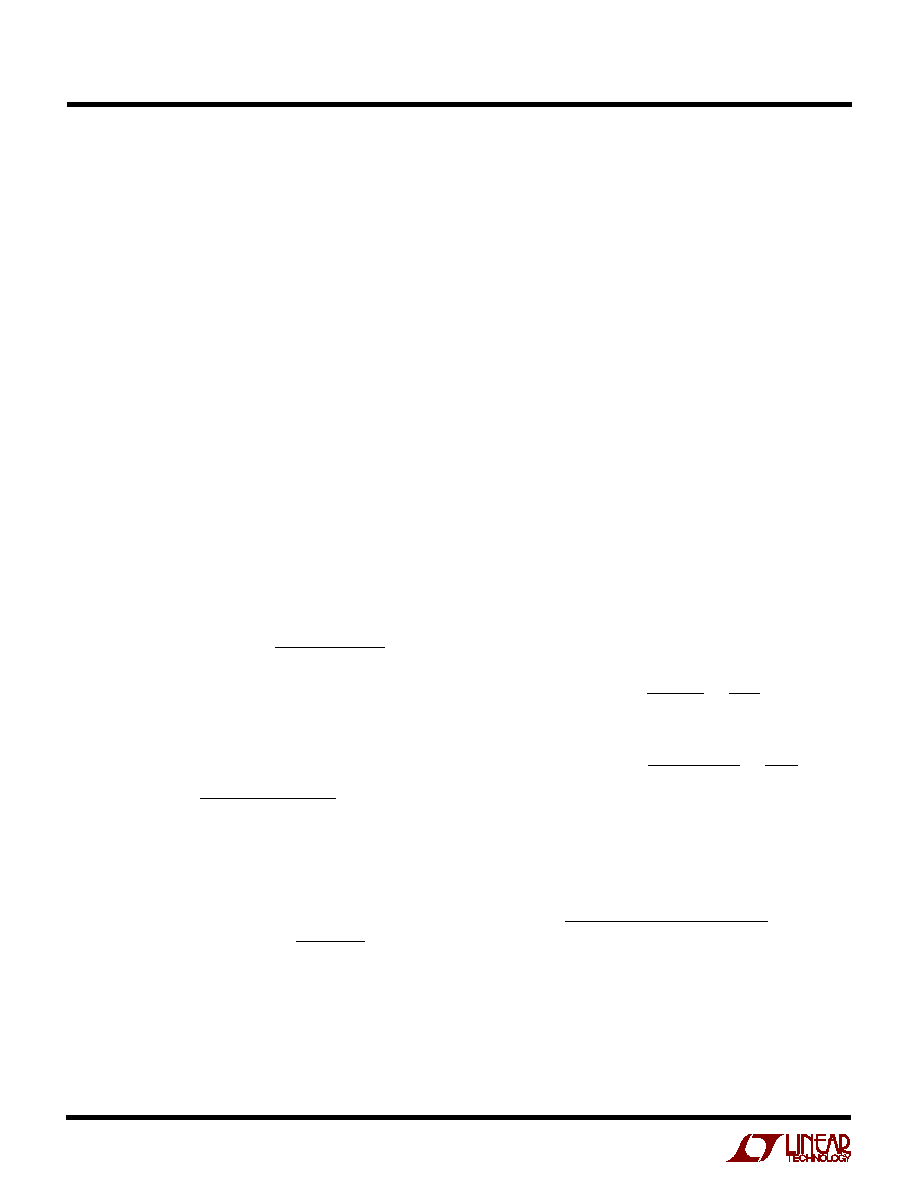
16
LTC1624
APPLICATIO
N
S I
N
FOR
M
ATIO
N
W
U
U
U
identical voltages are applied to L1 and L2 throughout the
switching cycle. By making L1 = L2 and wound on the
same core the input ripple is reduced along with cost and
size. All SEPIC applications information that follows
assumes L1 = L2 = L.
SEPIC Converter: Power MOSFET Selection
One external N-channel power MOSFET must be selected
for use with the LTC1624 for the switch. As in boost
applications the source of the power MOSFET is grounded
along with the SW pin. The peak-to-peak gate drive levels
are set by the INTV
CC
voltage. This voltage is equal to
approximately 5V for V
IN
> 5.6V and a logic level MOSFET
can be used. At V
IN
voltages below 5V the INTV
CC
voltage
is equal to V
IN
≠ 0.6V and a sublogic level MOSFET should
be used.
Selection criteria for the power MOSFET include the "ON"
resistance R
DS(ON)
, reverse transfer capacitance C
RSS
,
input voltage and maximum output current. When the
LTC1624 is operating in continuous mode the duty cycle
for the MOSFET is given by:
Main Switch Duty Cycle =
V
V
V
V
V
OUT
D
IN
OUT
D
+
+
+
The MOSFET power dissipation and maximum switch
current at maximum output current are given by:
P
I
V
V
V
V
V
R
k V
V
I
C
kHz
where
I
I
V
V
V
MAIN
SW MAX
OUT
D
IN MIN
OUT
D
DS ON
IN MIN
OUT
SW MAX
RSS
SW MAX
OUT MAX
OUT
D
IN MIN
=
+
+
+
+
( )
+
+
( )(
)
=
+
+
( )
( )
( )
( )
( )
( )
( )
( )
2
1 85
1
200
1
.
is the temperature dependency of R
DS(ON)
and k is a
constant inversely related to the gate drive current. The
peak switch current is I
SW(MAX)
+
I
L
.
MOSFETs have I
2
R losses plus the P
MAIN
equation
includes an additional term for transition losses that are
highest at high total input plus output voltages. For
(V
IN
+ V
OUT
) < 20V the high current efficiency generally
improves with larger MOSFETs, while for (V
IN
+ V
OUT
) >
20V the transition losses rapidly increase to the point that
the use of a higher R
DS(ON)
device with lower C
RSS
actual
provides higher efficiency. For additional information refer
to the Step-Down Converter: Power MOSFET Selection in
the Applications Information section.
SEPIC Converter: Inductor Selection
For most applications the equal inductor values will fall in
the range of 10
µ
H to 100
µ
H. Higher values reduce the
input ripple voltage and reduce core loss. Lower inductor
values are chosen to reduce physical size and improve
transient response.
Like the boost converter the input current of the SEPIC
converter is calculated at full load current. Peak inductor
current can be significantly higher than output current,
especially with smaller inductors and lighter loads. The
following formula assumes continuous mode operation
and calculates maximum peak inductor current at mini-
mum V
IN
:
I
I
L1 PEAK
L2 PEAK
( )
( ) ( )
( )
( )
( )
( )
=
+
=
+
+
I
V
V
I
I
V
V
V
I
OUT MAX
OUT
IN MIN
L
OUT MAX
IN MIN
D
IN MIN
L
1
2
2
2
The ripple current in the inductor (
I
L
) is typically 20% to
30% of the peak current occuring at V
IN(MIN)
and I
OUT(MAX)
,
and
I
L1
=
I
L2
. Maximum
I
L
occurs at maximum V
IN
.
I
V
V
V
kHz L V
V
V
L
IN
OUT
D
IN
OUT
D
P-P
( )
=
( )
+
(
)
(
)( )
+
+
(
)
200
By making L1 = L2 and wound on the same core
the value
of inductance in all the above equations are replaced by
2L due to their mutual inductance. Doing this maintains
the same ripple current and inductive energy storage in the
inductors. For example a Coiltronix CTX10-4 is a 10
µ
H
inductor with two windings. With the windings in parallel
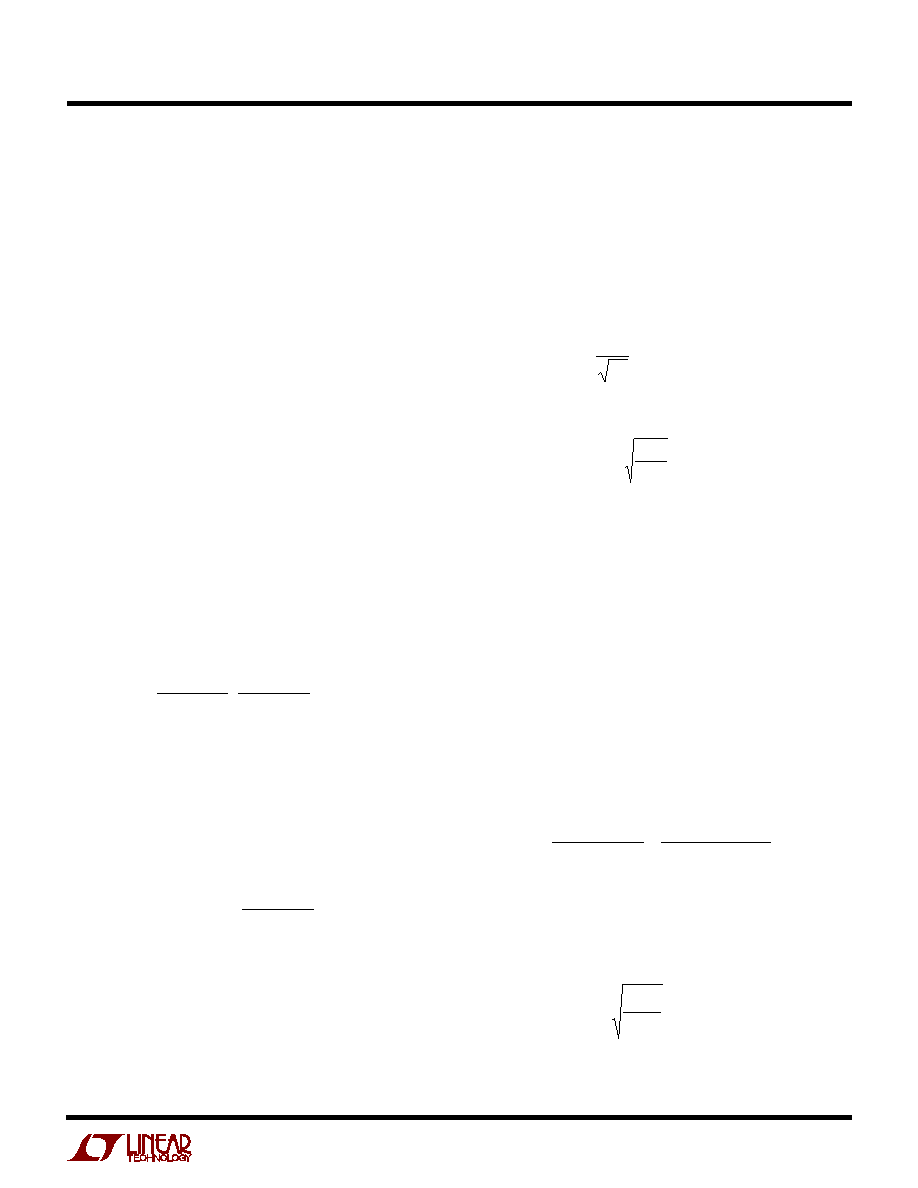
17
LTC1624
10
µ
H inductance is obtained with a current rating of 4A.
Splitting the two windings creates two 10
µ
H inductors
with a current rating of 2A each. Therefore substitute
(2)(10
µ
H) = 20
µ
H for L in the equations.
Specify the maximum inductor current to safely handle
I
L(PEAK)
. Make sure the inductor's saturation current rat-
ing (current when inductance begins to fall) exceeds the
maximum current rating set by R
SENSE
.
SEPIC Converter: R
SENSE
Selection for Maximum
Output Current
R
SENSE
is chosen based on the required output current.
Remember the LTC1624 current comparator has a maxi-
mum threshold of 160mV/R
SENSE
. The current compara-
tor threshold sets the peak of the inductor current, yielding
a maximum average output current I
OUT(MAX)
equal to
I
L1(PEAK)
less half the peak-to-peak ripple current,
I
L
,
divided by the output-input voltage ratio (see equation for
I
L1(PEAK)
)
.
Allowing a margin for variations in the LTC1624 (without
considering variation in R
SENSE
), assuming 30% ripple
current in the inductor, yields:
R
mV
I
V
V
V
SENSE
OUT MAX
IN MIN
OUT
D
=
+
( )
( )
100
SEPIC Converter: Output Diode
The output diode conducts current only during the switch
off-time. Peak reverse voltage for SEPIC converters is
equal to V
OUT
+ V
IN
. Average forward current in normal
operation is equal to output current. Peak current is:
I
I
V
V
V
I
D PEAK
OUT MAX
OUT
D
IN MIN
L
1
1
( )
( )
( )
=
+
+
+
Schottky diodes such as MBR130LT3 are recommended.
SEPIC Converter: Input and Output Capacitors
The output capacitor is normally chosen by its effective
series resistance (ESR), because this is what determines
APPLICATIO
N
S I
N
FOR
M
ATIO
N
W
U
U
U
output ripple voltage. The input capacitor needs to be sized
to handle the ripple current safely.
Since the output capacitor's ESR affects efficiency, use
low ESR capacitors for best performance. SEPIC regula-
tors, like step-down regulators, have a triangular current
waveform but have maximum ripple at V
IN(MAX)
. The input
capacitor ripple current is:
I
I
RIPPLE RMS
L
( )
=
12
The output capacitor ripple current is:
I
I
RIPPLE RMS
OUT
V
V
OUT
IN
( )
=
The output capacitor ripple voltage (RMS) is:
V
OUT(RIPPLE)
= 2(
I
L
)(ESR)
The input capacitor can see a very high surge current when
a battery is suddenly connected, and solid tantalum
capacitors can fail under this condition. Be sure to specify
surge tested capacitors.
SEPIC Converter: Coupling Capacitor (C1)
The coupling capacitor C1 in Figure 7 sees a nearly
rectangular current waveform. During the off-time the
current through C1 is I
OUT
(V
OUT
/V
IN
) while approximately
≠ I
OUT
flows though C1 during the on-time. This current
waveform creates a triangular ripple voltage on C1:
V
I
kHz C
V
V
V
V
C
OUT
OUT
IN
OUT
D
1
200
1
=
(
)( )
+
+
The maximum voltage on C1 is then:
V
C1(MAX)
= V
IN
+
V
C1
/2 (typically close to V
IN(MAX)
).
The ripple current though C1 is:
I
I
V
V
RIPPLE C
OUT
OUT
IN
1
( )
=
The maximum ripple current occurs at I
OUT(MAX)
and
V
IN(MIN)
. The capacitance of C1 should be large enough so
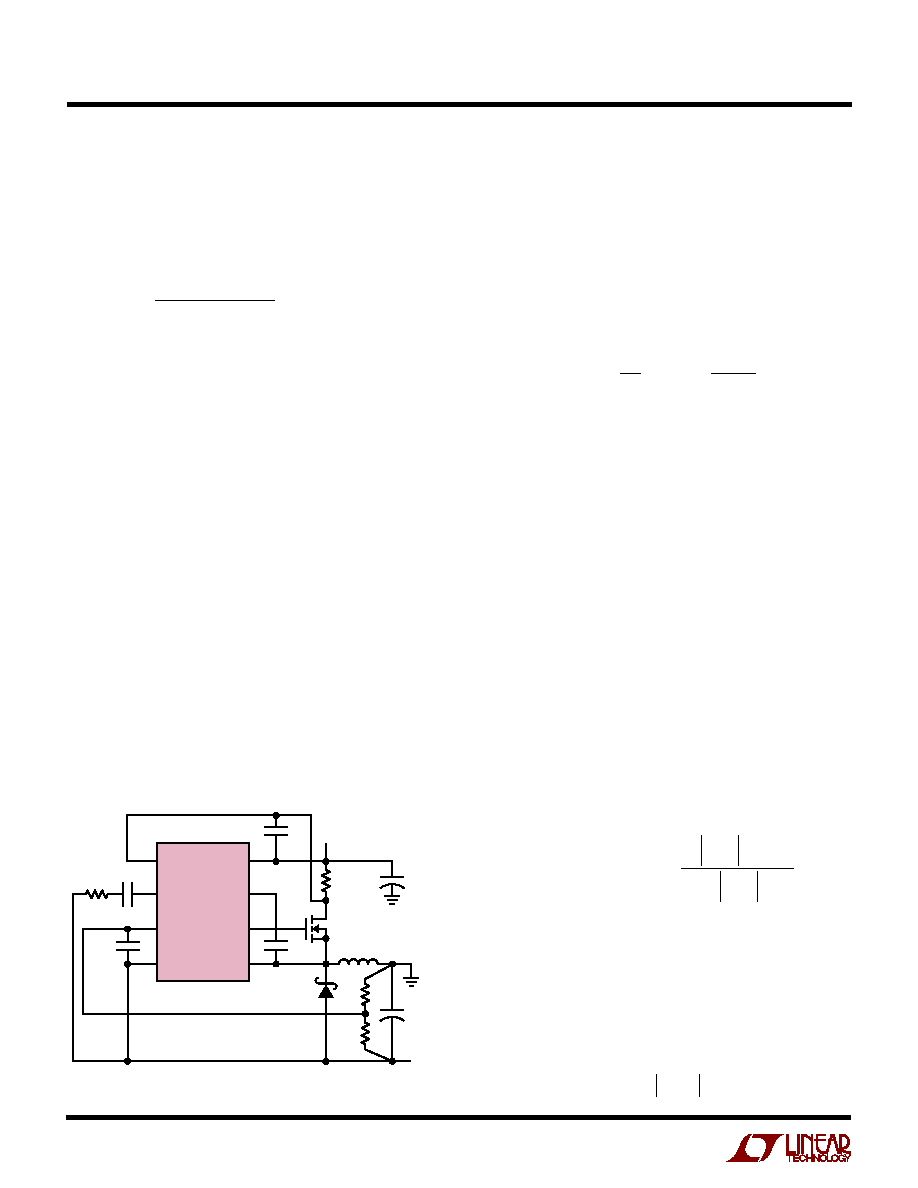
18
LTC1624
APPLICATIO
N
S I
N
FOR
M
ATIO
N
W
U
U
U
Positive-to-Negative Converter: Output Voltage
Programming
Setting the output voltage for a positive-to-negative con-
verter is different from other architectures since the feed-
back voltage is referenced to the LTC1624 ground pin and
the ground pin is referenced to ≠ V
OUT
. The output voltage
is set by a resistive divider according to the following
formula:
V
V
R
R
V
DC
DC
OUT
IN
=
+
-
-
1 19
1
1
2
1
.
The external resistive divider is connected to the output as
shown in Figure 8.
Positive-to-Negative Converter: Power
MOSFET Selection
One external N-channel power MOSFET must be selected
for use with the LTC1624 for the switch. As in step-down
applications the source of the power MOSFET is con-
nected to the Schottky diode and inductor. The peak-to-
peak gate drive levels are set by the INTV
CC
voltage. The
gate drive voltage is equal to approximately 5V for V
IN
>
5.6V and a logic level MOSFET can be used. At V
IN
voltages
below 5V the INTV
CC
voltage is equal to V
IN
≠ 0.6V and a
sublogic level MOSFET should be used.
Selection criteria for the power MOSFET include the "ON"
resistance R
DS(ON)
, reverse transfer capacitance C
RSS
,
input voltage and maximum output current. When the
LTC1624 is operating in continuous mode the duty cycle
for the MOSFET is given by:
Main
V
V
V
D
OUT
D
Switch Duty Cycle =
V
V
OUT
IN
+
+
+
with
V
OUT
being the absolute value of V
OUT
.
The MOSFET power dissipation and maximum switch
current are given by:
that the voltage across C1 is constant such that V
C1
= V
IN
at full load over the entire V
IN
range. Assuming the enegry
storage in the coupling capacitor C1 must be equal to the
enegry stored in L1, the minimum capacitance of C1 is:
C
L I
V
V
MIN
OUT
OUT
IN MIN
1
1
2
2
4
( )
( )
=
( ) ( )
SEPIC Converter: Duty Cycle Limitations
The minimum on-time of 450ns sets a limit on how high
an input-to-output ratio can be tolerated while not skip-
ping cycles. This only impacts designs when very low
output voltages (V
OUT
< 2.5V) are needed. Note that a
SEPIC converter would not be appropriate at these low
output voltages. The maximum input voltage is (remem-
ber not to exceed the absolute maximum limit of 36V):
V
IN(MAX)
= 10.1V
OUT
+ 5V For DC > 9%
Positive-to-Negative Converter Applications
The LTC1624 can also be used as a positive-to-negative
converter with a grounded inductor shown in Figure 8.
Since the LTC1624 requires a positive feedback signal
relative to device ground, Pin 4 must be tied to the
regulated negative output. A resistive divider from the
negative output to ground sets the output voltage.
Remember not to exceed maximum V
IN
ratings V
IN
+
V
OUT
36V.
P
MAIN
= I
SW MAX
◊
I
OUT MAX
I
+
R
DS ON
+
k V
IN MAX
+
V
OUT
1.85
C
RSS
200kHz
( )
( )
( )
( )
( )
( )(
)
(
)
{
{
Figure 8. Positive-to-Negative Converter
+
+
SENSE
≠
I
TH
/RUN
V
FB
GND
V
IN
BOOST
TG
SW
LTC1624
1000pF
8
7
6
5
1
2
3
4
100pF
C
C
R
C
D1
C
B
R1
R2
C
OUT
M1
L1
R
SENSE
C
IN
≠V
OUT
V
IN
1624 F08
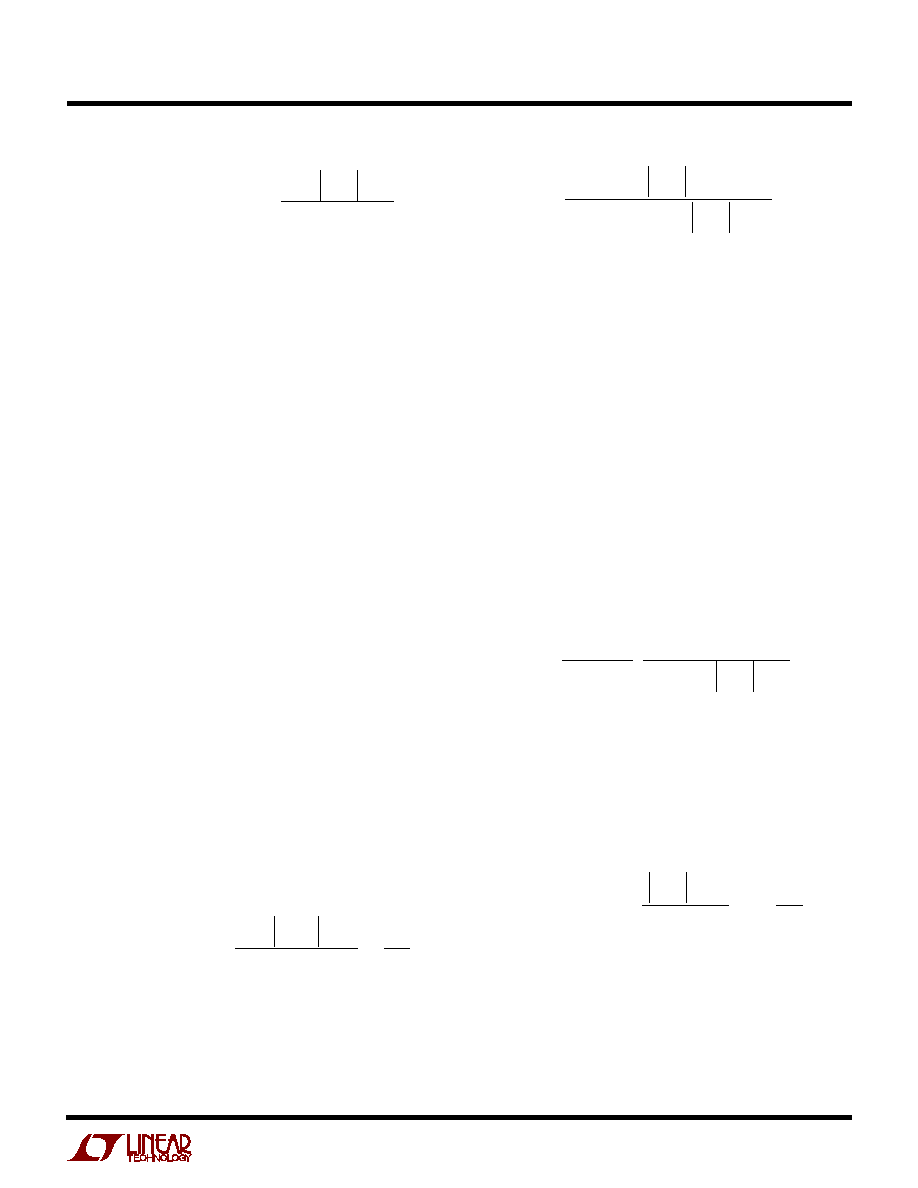
19
LTC1624
where
I
V
V
V
V
OUT MAX
IN
OUT
D
IN
:
I
SW MAX
( )
( )
=
+
+
is the temperature dependency of R
DS(ON)
and k is a
constant inversely related to the gate drive current. The
maximum switch current occurs at V
IN(MIN)
and the peak
switch current is I
SW(MAX)
+
I
L
/2. The maximum voltage
across the switch is V
IN(MAX)
+
V
OUT
.
MOSFETs have I
2
R losses plus the P
MAIN
equation
includes an additional term for transition losses that are
highest at high total input plus output voltages. For
(
V
OUT
+ V
IN
) < 20V the high current efficiency generally
improves with larger MOSFETs, while for (
V
OUT
+ V
IN
)
> 20V the transition losses rapidly increase to the point
that the use of a higher R
DS(ON)
device with lower C
RSS
actual provides higher efficiency. For additional informa-
tion refer to the Step-Down Converter: Power MOSFET
Selection in the Applications Information section.
Positive-to-Negative Converter: Inductor Selection
For most applications the inductor will fall in the range of
10
µ
H to 100
µ
H. Higher values reduce the input and output
ripple voltage (although not as much as step-down con-
verters) and also reduce core loss. Lower inductor values
are chosen to reduce physical size and improve transient
response but do increase output ripple.
Like the boost converter, the input current of the positive-
to-negative converter is calculated at full load current.
Peak inductor current can be significantly higher than
output current, especially with smaller inductors (with
high
I
L
values). The following formula assumes continu-
ous mode operation and calculates maximum peak induc-
tor current at minimum V
IN
:
I
I
V
V
V
V
I
L PEAK
OUT MAX
IN
OUT
D
IN
L
( )
( )
=
+
+
+
2
The ripple current in the inductor (
I
L
) is typically 20% to
50% of the peak inductor current occuring at V
IN(MIN)
and
I
OUT(MAX)
to minimize output ripple. Maximum
I
L
occurs
at minimum V
IN
.
APPLICATIO
N
S I
N
FOR
M
ATIO
N
W
U
U
U
I
V
V
V
kHz L V
V
V
L
IN
OUT
D
IN
OUT
D
P-P
( )
=
( )
+
(
)
(
)( )
+
+
(
)
200
Specify the maximum inductor current to safely handle
I
L(PEAK)
. Make sure the inductor's saturation current rat-
ing (current when inductance begins to fall) exceeds the
maximum current rating set by R
SENSE
.
Positive-to-Negative Converter: R
SENSE
Selection for
Maximum Output Current
R
SENSE
is chosen based on the required output current.
Remember the LTC1624 current comparator has a maxi-
mum threshold of 160mV/R
SENSE
. The current compara-
tor threshold sets the peak of the inductor current, yielding
a maximum average output current I
OUT(MAX)
equal to
I
L(PEAK)
less half the peak-to-peak ripple current with the
remainder divided by the duty cycle.
Allowing a margin for variations in the LTC1624 (without
considering variation in R
SENSE
) and assuming 30% ripple
current in the inductor, yields:
R
mV
I
V
V
V
V
SENSE
OUT MAX
IN MIN
IN MIN
OUT
D
=
+
+
( )
( )
( )
100
Positive-to-Negative Converter: Output Diode
The output diode conducts current only during the switch
off-time. Peak reverse voltage for positive-to-negative
converters is equal to
V
OUT
+ V
IN
. Average forward
current in normal operation is equal to I
D(PEAK)
≠
I
L
/2.
Peak diode current (occurring at V
IN(MIN)
) is:
I
I
V
V
V
I
D PEAK
OUT MAX
OUT
D
IN
L
( )
( )
=
+
(
)
+
+
1
2
Positive-to-Negative Converter: Input and
Output Capacitors
The output capacitor is normally chosen by its effective
series resistance (ESR), because this is what determines
output ripple voltage. Both input and output capacitors
need to be sized to handle the ripple current safely.

20
LTC1624
Positive-to-negative converters have high ripple current in
both the input and output capacitors. For long capacitor
lifetime, the RMS value of this current must be less than
the high frequency ripple rating of the capacitor.
The following formula gives an approximate value for RMS
ripple current. This formula assumes continuous mode
and low current ripple. Small inductors will give somewhat
higher ripple current, especially in discontinuous mode.
For the exact formulas refer to Application Note 44, pages
28 to 30. The input and output capacitor ripple current
(occurring at V
IN(MIN)
) is:
Capacitor
ff I
V
V
OUT
OUT
IN
I
RMS
=
( )( )
ff = Fudge factor (1.2 to 2.0)
The output peak-to-peak ripple voltage is:
V
OUT(P-P)
= R
ESR
(I
D(MAX)
)
The input capacitor can also see a very high surge current
when a battery is suddenly connected, and solid tantalum
capacitors can fail under this condition. Be sure to specify
surge tested capacitors.
Positive-to-Negative Converter: Duty Cycle
Limitations
The minimum on-time of 450ns sets a limit on how high
of input-to-output ratio can be tolerated while not skipping
cycles. This only impacts designs when very low output
voltages (
V
OUT
< 2.5V) are needed. The maximum input
voltage is:
V
IN(MAX)
< 10.1V
OUT
+ 5V For DC > 9%
V
IN(MAX)
< 36V ≠
V
OUT
For absolute maximum ratings
Positive-to-Negative Converter: Shutdown
Considerations
Since the ground pin on the LTC1624 is referenced to
≠ V
OUT
, additional circuitry is needed to put the LTC1624
into shutdown. Shutdown is enabled by pulling the
I
TH
/RUN pin below 0.8V relative to the LTC1624 ground
pin. With the LTC1624 ground pin referenced to ≠ V
OUT
,
the nonimal range on the I
TH
/RUN pin is ≠ V
OUT
(in
shutdown) to (≠ V
OUT
+ 2.4V)(at Max I
OUT
). Referring to
Figure 15, M2, M3 and R3 provide a level shift from typical
TTL levels to the LTC1624 operating as positive-to-nega-
tive converter. MOSFET M3 supplies gate drive to M2
during shutdown, while M2 pulls the I
TH/RUN
pin voltage to
≠ V
OUT
, shutting down the LTC1624.
Step-Down Converters: PC Board Layout Checklist
When laying out the printed circuit board, the following
checklist should be used to ensure proper operation of the
LTC1624. These items are also illustrated graphically in
the layout diagram of Figure 9. Check the following in your
layout:
1. Are the signal and power grounds segregated? The
LTC1624 ground (Pin 4) must return to the (≠) plate
of C
OUT.
2. Does the V
FB
(Pin 3) connect directly to the feedback
resistors? The resistive divider R1, R2 must be con-
nected between the (+) plate of C
OUT
and signal ground.
The 100pF capacitor should be as close as possible to
the LTC1624.
3. Does the V
IN
lead connect to the input voltage at the
same point as R
SENSE
and are the SENSE
≠
and V
IN
leads
routed together with minimum PC trace spacing? The
filter capacitor between V
IN
and SENSE
≠
should be as
close as possible to the LTC1624.
4. Does the (+) plate of C
IN
connect to R
SENSE
as closely
as possible? This capacitor provides the AC current to
the MOSFET(s). Also, does C
IN
connect as close as
possible to the V
IN
and ground pin of the LTC1624?
This capacitor also supplies the energy required to
recharge the bootstrap capacitor. Adequate input
decoupling is critical for proper operation.
5. Keep the switch node SW away from sensitive small-
signal nodes. Ideally, M1, L1 and D1 should be con-
nected as closely as possible at the switch node.
APPLICATIO
N
S I
N
FOR
M
ATIO
N
W
U
U
U
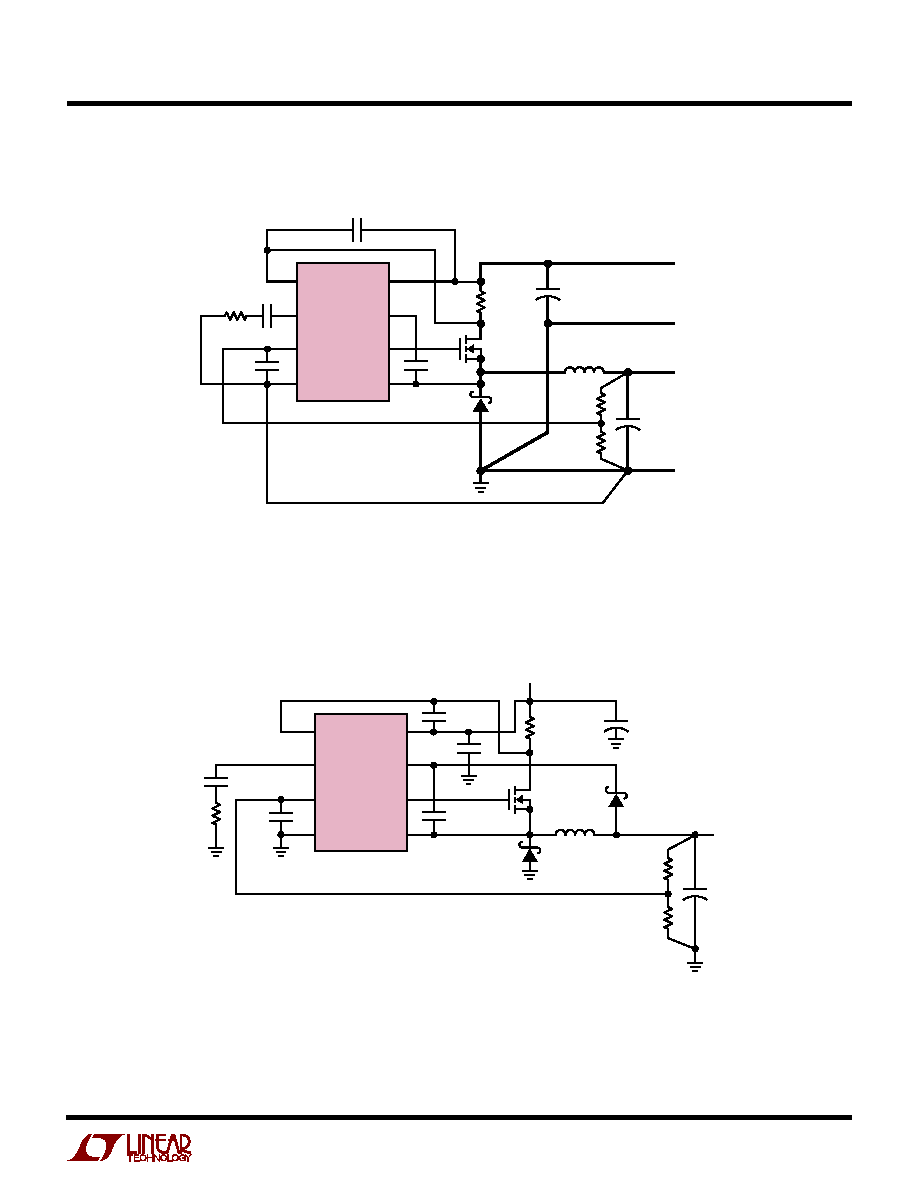
21
LTC1624
TYPICAL APPLICATIO
N
S
U
Figure 9. LTC1624 Layout Diagram (See Board Layout Checklist)
+
+
SENSE
≠
I
TH
/RUN
V
FB
GND
V
IN
BOOST
TG
SW
LTC1624
1000pF
100pF
C
C
560pF
R
C
4.7k
D1
MBRS340T3
D2
CMDSH-3
C
B
0.1
µ
F
8
7
6
5
1
2
3
4
R2
35.7k
1%
R1
11k
1%
C
OUT
100
µ
F
10V
◊
2
M1
Si4412DY
L1*
10
µ
H
R
SENSE
0.033
C
IN
22
µ
F
35V
◊
2
V
OUT
5V
3A
V
IN
5.3V TO 28V
1624 F10
*COILTRONICS CTX10-4
0.1
µ
F
Figure 10. 5V/3A Converter with Output Derived Boost Voltage
+
SENSE
≠
I
TH
/RUN
V
FB
GND
V
IN
BOOST
TG
SW
LTC1624
1000pF
8
7
6
5
1
2
3
4
100pF
BOLD LINES INDICATE
HIGH CURRENT PATHS
C
C
R
C
D1
C
B
0.1
µ
F
R2
R1
C
OUT
M1
L1
+
≠
R
SENSE
C
IN
V
IN
+
≠
V
OUT
1624 F09
+
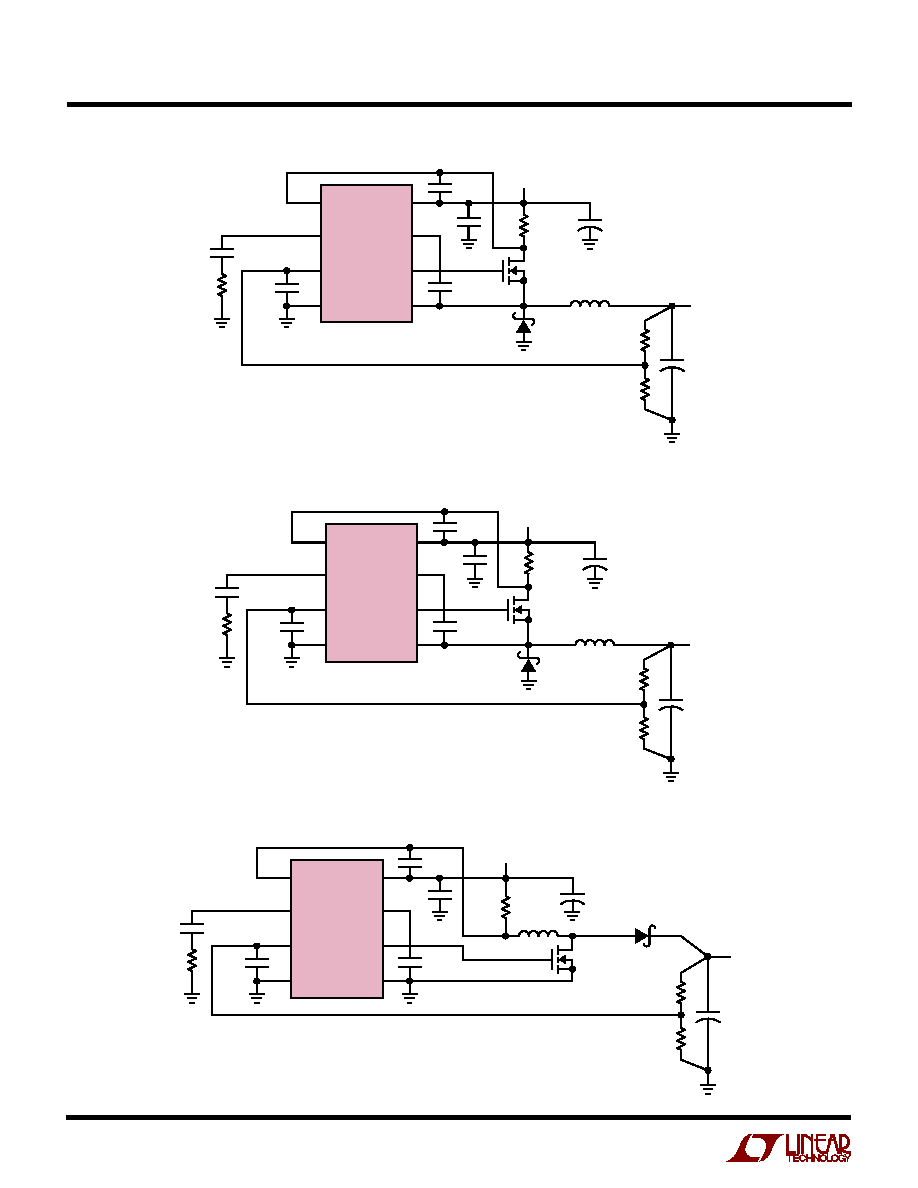
22
LTC1624
TYPICAL APPLICATIO
N
S
U
+
+
SENSE
≠
I
TH
/RUN
V
FB
GND
V
IN
BOOST
TG
SW
LTC1624
1000pF
100pF
C
C
330pF
R
C
3.3k
D1
MBRS130LT3
C
B
0.1
µ
F
8
7
6
5
1
2
3
4
R2
35.7k
1%
R1
3.92k
1%
C
OUT
100
µ
F
16V
◊
2
M1
Si4412DY
L1*
22
µ
H
R
SENSE
0.04
C
IN
22
µ
F
35V
◊
2
V
OUT
12V
0.75A
V
IN
5.2V TO 11V
1624 F13
*SUMIDA CDRH125-220
0.1
µ
F
Figure 11. Wide Input Range 1.8V/1.5A Converter
+
+
SENSE
≠
I
TH
/RUN
V
FB
GND
V
IN
BOOST
TG
SW
LTC1624
1000pF
100pF
C
C
470pF
R
C
6.8k
D1
MBRS140T3
C
B
0.1
µ
F
8
7
6
5
1
2
3
4
R2
35.7k
1%
R1
3.92k
1%
C
OUT
100
µ
F
16V
◊
2
M1
Si4412DY
L1*
47
µ
H
R
SENSE
0.068
C
IN
22
µ
F
35V
◊
2
V
OUT
12V
1A
V
IN
12.3V TO 28V
1624 F12
*SUMIDA CDRH125-470
0.1
µ
F
Figure 12. 12V/1A Low Dropout Converter
Figure 13. 12V/0.75A Boost Converter
+
+
SENSE
≠
I
TH
/RUN
V
FB
GND
V
IN
BOOST
TG
SW
LTC1624
1000pF
100pF
C
C
470pF
R
C
6.8k
D1
MBRS340T3
C
B
0.1
µ
F
8
7
6
5
1
2
3
4
R2
35.7k
1%
R1
69.8k
1%
C
OUT
100
µ
F
10V
◊
2
M1
Si6436DY
L1*
10
µ
H
R
SENSE
0.068
C
IN
22
µ
F
35V
◊
2
V
OUT
1.8V
1.5A
V
IN
4.8V TO 22V
1624 F11
*SUMIDA CDR105B-100
0.1
µ
F
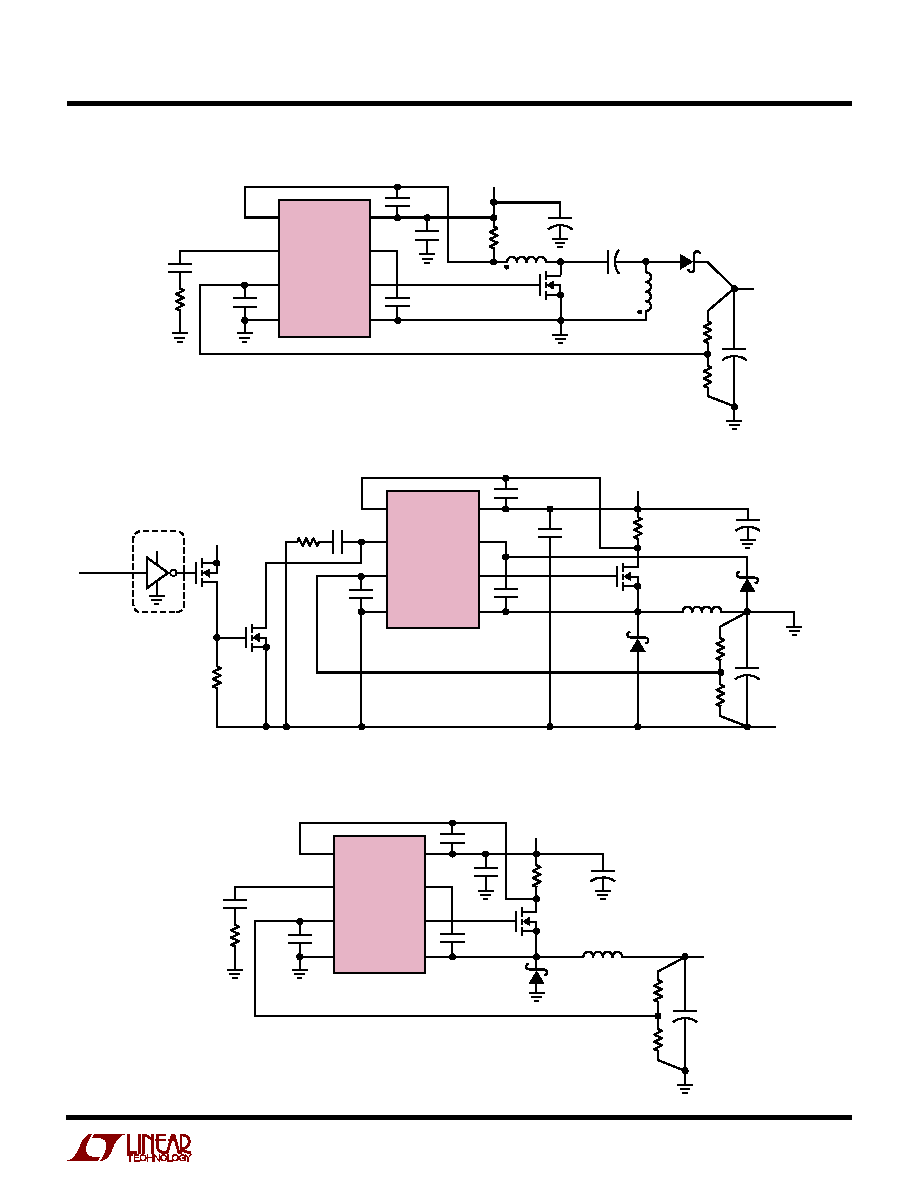
23
LTC1624
TYPICAL APPLICATIO
N
S
U
+
+
+
SENSE
≠
I
TH
/RUN
V
FB
GND
V
IN
BOOST
TG
SW
LTC1624
1000pF
100pF
C
C
330pF
R
C
4.7k
D1
MBRS130LT3
C
B
0.1
µ
F
8
7
6
5
1
2
3
4
R2
35.7k
1%
R1
3.92k
1%
C
OUT
100
µ
F
16V
◊
2
M1
Si4412DY
L1a*
L1b*
R
SENSE
0.068
C
IN
22
µ
F
35V
22
µ
F
35V
V
OUT
12V
0.5A
V
IN
5V TO 15V
1624 F14
*COILTRONICS CTX20-4
0.1
µ
F
+
+
SENSE
≠
I
TH
/RUN
V
FB
GND
V
IN
BOOST
TG
SW
LTC1624
1000pF
100pF
C
C
470pF
R
C
6.8k
D1
MBRS340T3
C
B
0.1
µ
F
8
7
6
5
1
2
3
4
R2
35.7k
1%
R1
20k
1%
C
OUT
100
µ
F
10V
◊
2
M1
Si6426DQ
L1*
20
µ
H
R
SENSE
0.068
C
IN
22
µ
F
35V
◊
2
V
OUT
3.3V
1.5A
V
IN
3.5V TO 18V
1624 F16
*COILTRONICS CTX20-4
0.1
µ
F
Figure 16. Low Dropout 3.3V/1.5A Converter
Figure 14. 12V/0.4A SEPIC Converter
Figure 15. Inverting ≠ 5V/2A Converter
+
+
SENSE
≠
I
TH
/RUN
V
FB
GND
V
IN
BOOST
TG
SW
LTC1624
1000pF
0.1
µ
F
100pF
C
C
1000pF
R
C
3.3k
R3
100k
V
CC
V
CC
SHUTDOWN
D1
MBRS340T3
D2
CMDSH-3
C
B
0.1
µ
F
8
7
6
5
1
2
3
4
R2
78.7k
1%
R1
24.9k
1%
C
OUT
100
µ
F
10V
◊
2
M2
VN2222
M3
TP0610L
M1
Si4410DY
L1*
33
µ
H
R
SENSE
0.025
C
IN
22
µ
F
35V
◊
2
V
OUT
≠5V
2A
V
IN
5V TO 22V
1624 F15
*COILCRAFT DO5022P-333
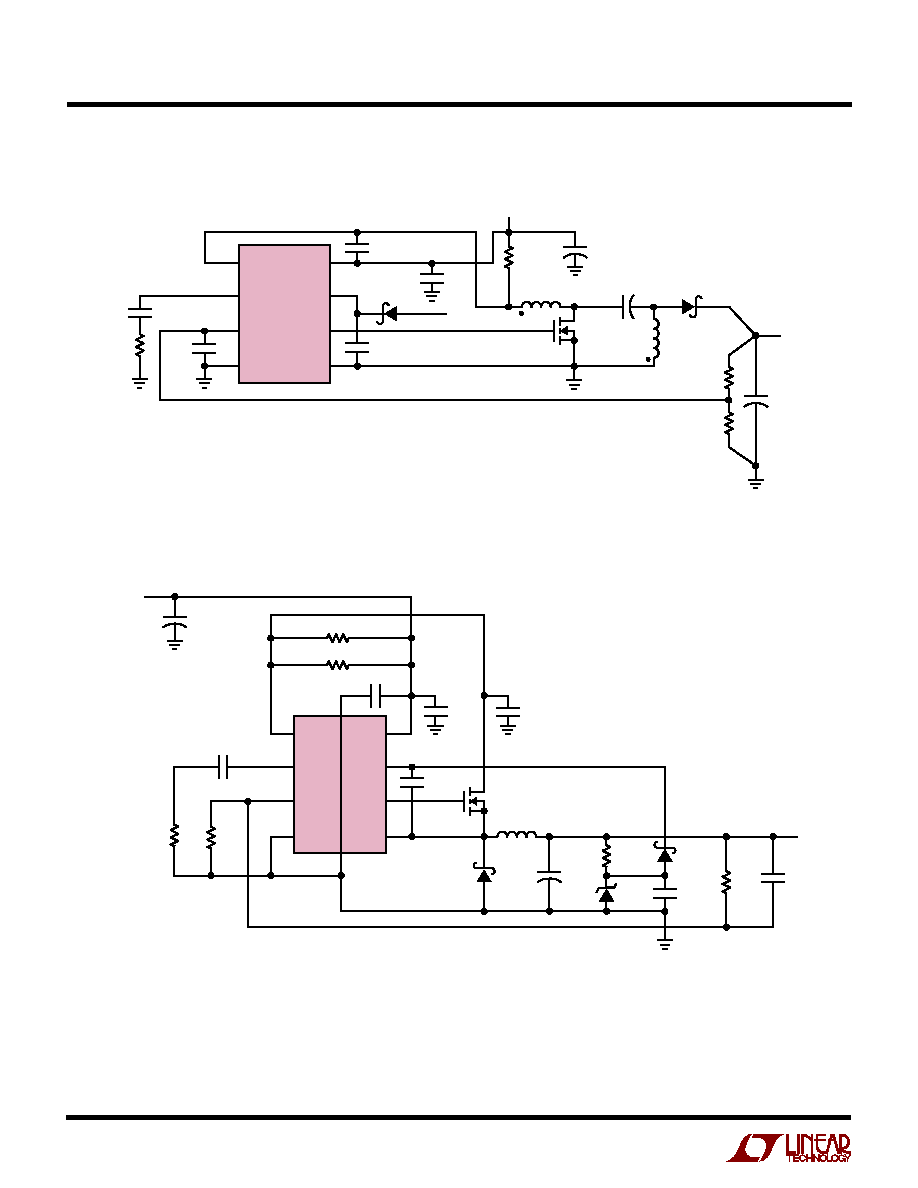
24
LTC1624
TYPICAL APPLICATIO
N
S
U
+
+
SENSE
≠
I
TH
/RUN
V
FB
GND
V
IN
BOOST
TG
SW
LTC1624
1000pF
100pF
C
C
330pF
R
C
6.8k
D1
MBRS130LT3
D2
CMDSH-3
C
B
0.1
µ
F
8
7
6
5
1
2
3
4
+
R2
35.7k
1%
R1
11k
1%
C
OUT
100
µ
F
16V
◊
2
M1
Si6426DQ
L1b*
L1a*
R
SENSE
0.05
C
IN
22
µ
F
35V
◊
2
22
µ
F
35V
V
OUT
5V
1A
V
OUT
V
IN
3.6V TO 18V
1624 F17
* COILTRONICS CTX20-4
0.1
µ
F
Figure 17. 5V/1A SEPIC Converter with Output Derived Boost Voltage
Figure 18. 24V to 12V/10A Buck Converter with Output-Derived Boost Voltage
+
SENSE
≠
I
TH
/RUN
V
FB
GND
V
IN
BOOST
TG
SW
LTC1624
C
IN1
, C
IN2
1000
µ
F
35V
◊
2
V
IN
13V TO
28V
D1*
C
B
0.1
µ
F
C5
3.3
µ
F
50V
C4, 0.1
µ
F
8
7
6
5
1
2
3
4
R
SENSE2
, 0.015
R1
11k
1%
R
C
20k
C
C
100pF
M1*
C
OUT
2700
µ
F
16V
R5
220
R2
100k
1%
Z1
IN 755
L1
V
OUT
12V
10A
1624 F18
C
IN1
, C
IN2
= SANYO 35MV1000GX
C5, C7 = WIMA MKS2
C
OUT
= SANYO 16MV2700GX
D1 = MOTOROLA MBR2535CT
L1 = PULSE ENGINEERING PO472
M1 = INTERNATIONAL RECTIFIER IRL3803
R
SENSE1
, R
SENSE2
= IRC LR2010-01-R015-F
* BOTH D1 AND M1 MOUNTED TO SAME
THERMALLOY #6399B HEAT SINK
R
SENSE1
, 0.015
+
C7
3.3
µ
F
50V
C9
0.1
µ
F
C10
220pF
D2
MBR0540

25
LTC1624
TYPICAL APPLICATIO
N
S
U
Figure 20. 12V to 24V/5A Boost Converter
+
SENSE
≠
I
TH
/RUN
V
FB
GND
V
IN
BOOST
TG
SW
LTC1624
C3
100pF
C4
1500pF
C
IN
100
µ
F
16V
V
IN
9V TO
15V
V
OUT
24V
5A
D1*
C
B
0.1
µ
F
C5
0.1
µ
F
8
7
6
5
1
2
3
4
R2, 1M, 1%
R
SENSE
0.005
, 5%
R1
52.3k
R5
750
0.5W
R
C
27k
C
C
4700pF
M1*
C
OUT1
1000
µ
F
35V
+
C
OUT2
1000
µ
F
35V
Z1
IN755
7.5V
L1
10
µ
H
1624 F20
C
IN
= KEMET T495X107M016AS
C
OUT1
, C
OUT2
= SANYO 35MV 1000GX
D1 = MOTOROLA MBR2535CT
L1 = MAGNETICS CORE #55930AZ WINDING = 8T#14BIF
M1 = INTERNATIONAL RECTIFIER IRL 3803
R
SENSE
= IRC OAR-3, 0.005
, 5%
+
*BOTH D1 AND Q1 MOUNTED ON
THERMALLOY MODEL 6399 HEAT SINK
+
SENSE
≠
I
TH
/RUN
V
FB
GND
V
IN
BOOST
TG
SW
LTC1624
C3
100pF
C
IN
22
µ
F
35V
V
IN
20V TO
32V
D1
C
B
0.1
µ
F
C5
0.1
µ
F
8
7
6
5
1
2
3
4
R2, 1M, 1%
R
SENSE
0.025
R1
13.3k
R
C
6.8k
C
C
820pF
M1
C
OUT
100
µ
F
100V
L1
47
µ
H
V
OUT
90V
0.5A
1624 F19
C
IN
= KEMET T495X226M035AS
C
OUT
= SANYO 100MV100GX
D1 = MOTOROLA MBRS1100
L1 = COILCRAFT D05022P-473
M1 = INTERNATIONAL RECTIFIER IRL 540NS
R
SENSE
= IRC LR2010-01-R025-F
+
Figure 19. 24V to 90V at 0.5A Boost Converter
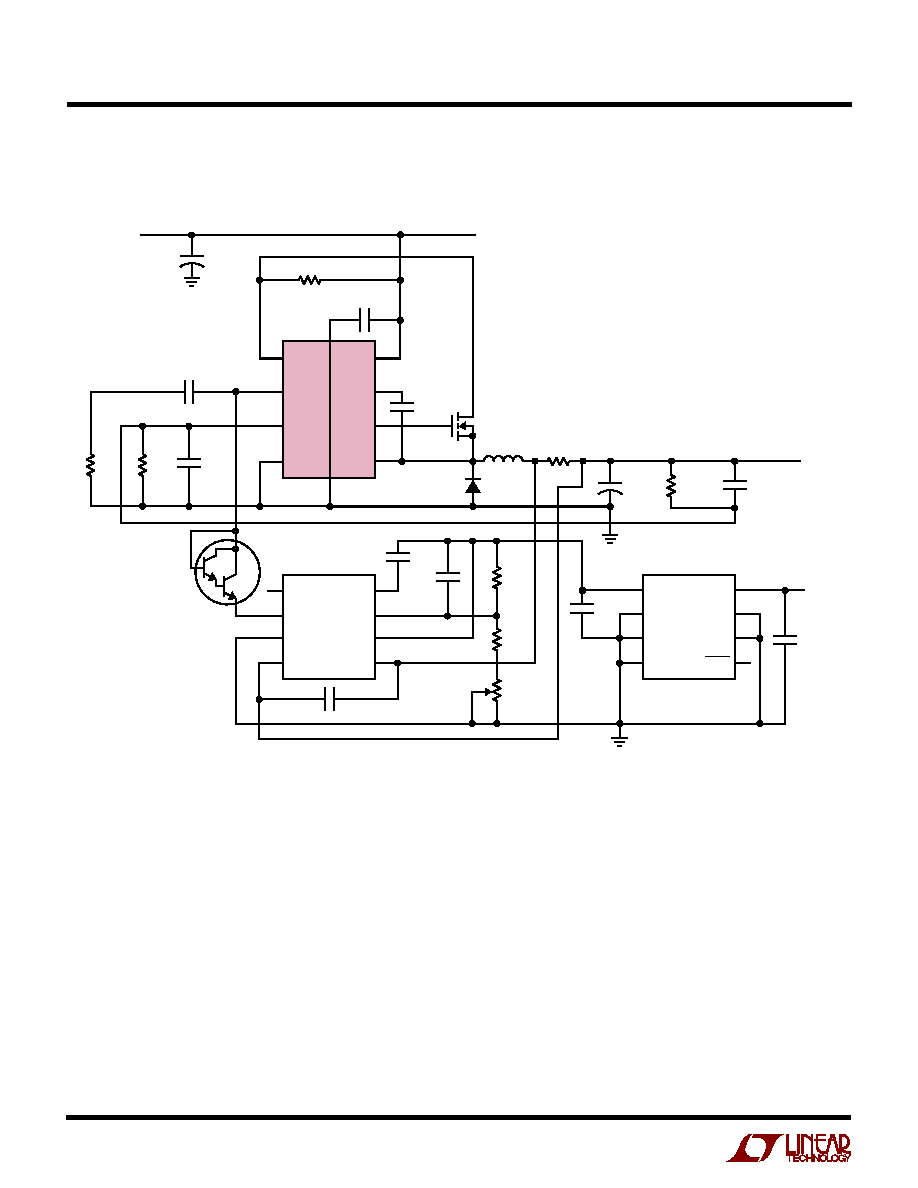
26
LTC1624
TYPICAL APPLICATIO
N
S
U
SENSE
≠
I
TH
/RUN
V
FB
GND
V
IN
BOOST
TG
SW
LTC1624
C4
100pF
C
IN1
, C
IN2
22
µ
F
35V
◊
2
V
IN
13V TO
28V
+V
IN
D1
MBRS340
C
B
0.1
µ
F
C10
0.1
µ
F
C11
0.1
µ
F
C12
1
µ
F
C9
100pF
C13
0.1
µ
F
+V
IN
C5, 0.1
µ
F
8
7
6
5
1
2
3
4
R
SENSE
0.033
R1
3.92k
R6
10k
R7
56k
R8
1M
CURRENT
ADJ
R2
35.7k
R
C
10k
C
C
330pF
M1
C
OUT
100
µ
F
16V
◊
2
L1
27
µ
H
R4
0.025
V
OUT
12V
3A
1624 F21
C
IN1
, C
IN2
= KEMET T495X226M035AS
L1 = SUMIDA CDRH127-270
R
SENSE
= IRC LR2010-01-R033-F
R4 = IRC LR2010-01-R025-F
M1 = SILICONIX Si4412DY
Q2 = MOTOROLA MMBT A14
C14, 0.01
µ
F
+
SENSE
I
OUT
GND
≠IN
AVE
PROG
V
CC
+IN
1
2
3
4
8
7
6
5
LTC1620
OUT
NC/ADJ
GND
NC
IN
NC
NC
SHDN
1
2
3
4
8
7
6
5
LT1121-5
+
Q2
Figure 21. 12V/3A Adjustable Current Power Supply for Battery Charger or Current Source Applications
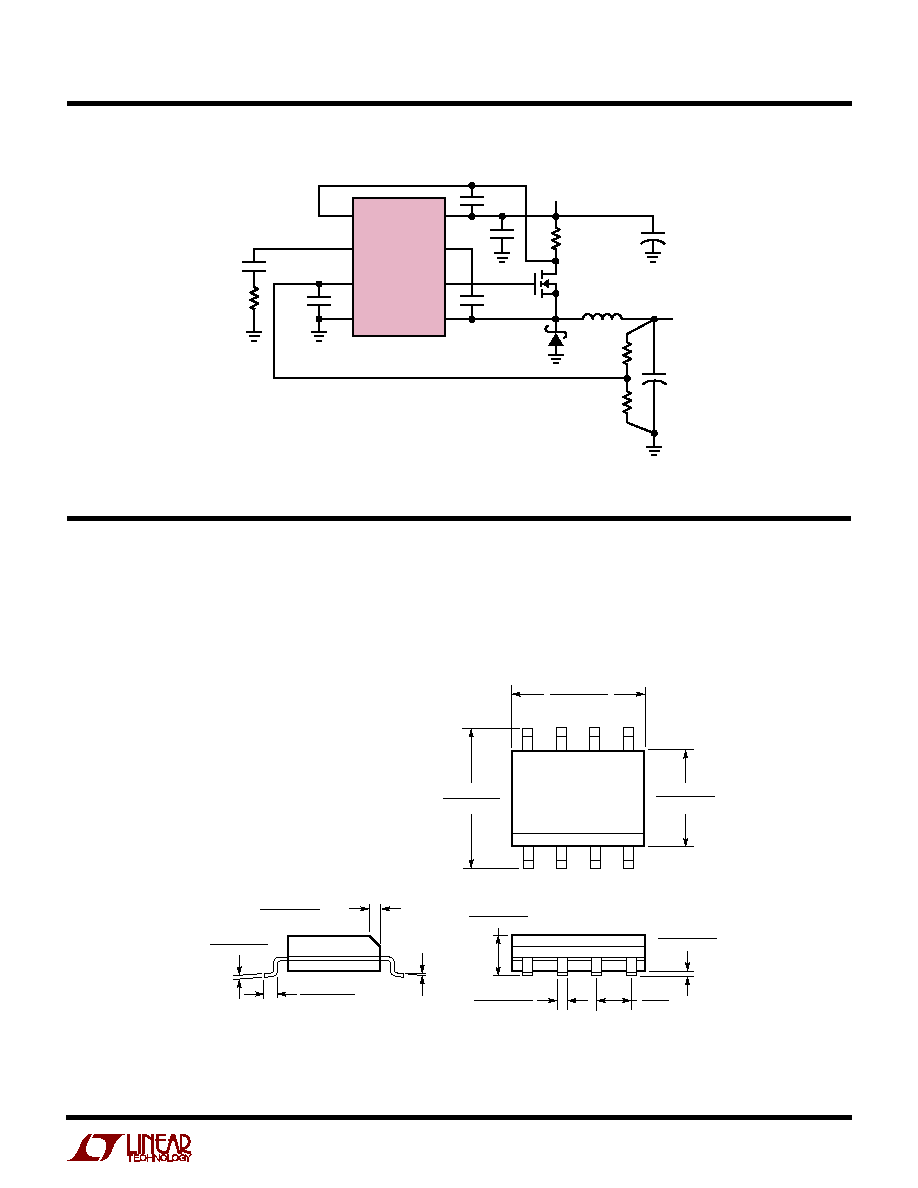
27
LTC1624
TYPICAL APPLICATIO
N
S
U
Information furnished by Linear Technology Corporation is believed to be accurate and reliable.
However, no responsibility is assumed for its use. Linear Technology Corporation makes no represen-
tation that the interconnection of its circuits as described herein will not infringe on existing patent rights.
1
2
3
4
0.150 ≠ 0.157**
(3.810 ≠ 3.988)
8
7
6
5
0.189 ≠ 0.197*
(4.801 ≠ 5.004)
0.228 ≠ 0.244
(5.791 ≠ 6.197)
0.016 ≠ 0.050
0.406 ≠ 1.270
0.010 ≠ 0.020
(0.254 ≠ 0.508)
◊
45
∞
0
∞
≠ 8
∞
TYP
0.008 ≠ 0.010
(0.203 ≠ 0.254)
SO8 0996
0.053 ≠ 0.069
(1.346 ≠ 1.752)
0.014 ≠ 0.019
(0.355 ≠ 0.483)
0.004 ≠ 0.010
(0.101 ≠ 0.254)
0.050
(1.270)
TYP
DIMENSION DOES NOT INCLUDE MOLD FLASH. MOLD FLASH
SHALL NOT EXCEED 0.006" (0.152mm) PER SIDE
DIMENSION DOES NOT INCLUDE INTERLEAD FLASH. INTERLEAD
FLASH SHALL NOT EXCEED 0.010" (0.254mm) PER SIDE
*
**
PACKAGE DESCRIPTIO
N
U
Dimensions in inches (millimeters) unless otherwise noted.
S8 Package
8-Lead Plastic Small Outline (Narrow 0.150)
(LTC DWG # 05-08-1610)
Figure 22. High Current 3.3V/6.5A Converter
+
+
SENSE
≠
I
TH
/RUN
V
FB
GND
V
IN
BOOST
TG
SW
LTC1624
1000pF
0.1
µ
F
100pF
C
C
680pF
R
C
3.3k
D1
MBRD835L
C
B
0.1
µ
F
8
7
6
5
1
2
3
4
R2
35.7k
1%
R1
20k
1%
C
OUT
100
µ
F
10V
◊
3
M1**
L1*
8
µ
H
R
SENSE
0.015
C
IN
22
µ
F
35V
◊
3
V
OUT
3.3V
6.5A
V
IN
4.8V TO 28V
1624 F22
* PANASONIC 12TS-7ROLB
** SILICONIX SUD50N03-10
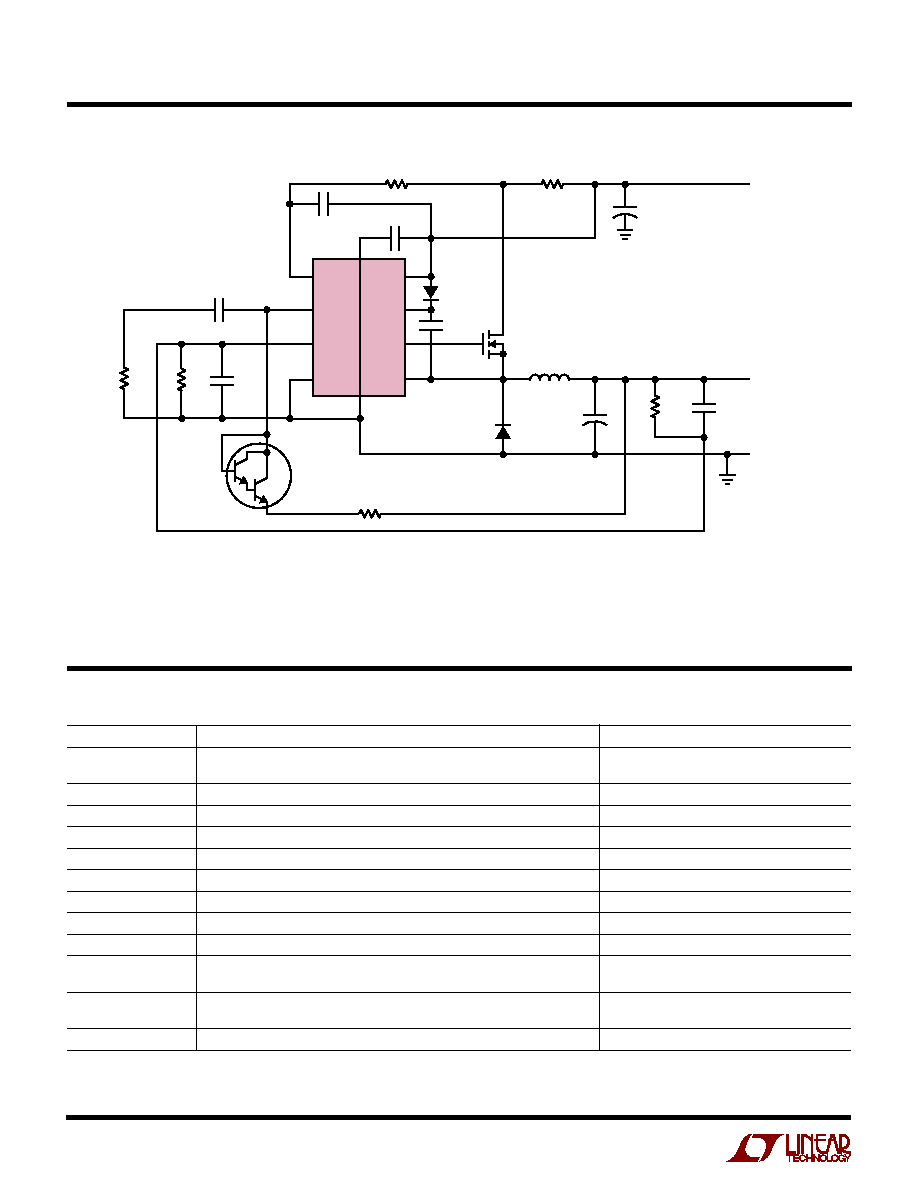
28
LTC1624
1624f LT/TP 0198 4K ∑ PRINTED IN USA
©
LINEAR TECHNOLOGY CORPORATION 1997
Linear Technology Corporation
1630 McCarthy Blvd., Milpitas, CA 95035-7417
q
(408) 432-1900
FAX: (408) 434-0507
q
TELEX: 499-3977
q
www.linear-tech.com
TYPICAL APPLICATIO
N
U
PART NUMBER
DESCRIPTION
COMMENTS
LTC1147
High Efficiency Step-Down Controller
100% DC, Burst Mode Operation, 8-Pin SO
and PDIP
LTC1148HV/LTC1148
High Efficiency Synchronous Step-Down Controllers
100% DC, Burst Mode Operation, V
IN
< 20V
LTC1149
High Efficiency Synchronous Step-Down Controller
100% DC,Std Threshold MOSFETs, V
IN
< 48V
LTC1159
High Efficiency Synchronous Step-Down Controller
100% DC, Logic Level MOSFETs, V
IN
< 40V
LTC1174
Monolithic 0.6A Step-Down Switching Regulator
100% DC, Burst Mode Operation, 8-Pin SO
LTC1265
1.2A Monolithic High Efficiency Step-Down Switching Regulator
100% DC, Burst Mode Operation, 14-Pin SO
LTC1266
High Efficiency Synchronous Step-Down Controller, N-Channel Drive
100% DC, Burst Mode Operation, V
IN
< 20V
LT
Æ
1375/LT1376
1.5A, 500kHz Step-Down Switching Regulators
High Frequency
LTC1433/LTC1434
Monolithic 0.45A Low Noise Current Mode Step-Down Switching Regulators
16- and 20-Pin Narrow SSOP
LTC1435
High Efficiency Low Noise Synchronous Step-Down Controller,
Burst Mode Operation, 16-Pin Narrow SO
N-Channel Drive
LTC1436/LTC1436-PLL
High Efficiency Low Noise Synchronous Step-Down Controllers,
Adaptive Power
TM
Mode, 20- and 24-Pin SSOP
N-Channel Drive
LTC1474/LTC1475
Ultralow Quiesent Current Step-Down Monolithic Switching Regulators
100% DC, 8-Pin MSOP, V
IN
< 20V
Adaptive Power is a trademark of Linear Technology Corporation.
RELATED PARTS
Figure 23. 5V to 3.3V/10A Converter (Surface Mount)
+
SENSE
≠
I
TH
/RUN
V
FB
GND
V
IN
BOOST
TG
SW
LTC1624
D1
10k
Q2
C
B
0.1
µ
F
C2
100pF
C
IN
100
µ
F
10V
◊
4
C4, 0.1
µ
F
C3, 0.033
µ
F
8
7
6
5
1
2
3
4
R
SENSE
0.0082
R
C
6.8k
C
C
820pF
M1
C
OUT
470
µ
F
6.3V
◊
2
L1
1.68
µ
H
+V
OUT
3.3V
10A
+V
IN
4.5V TO
5.5V
V
OUT
RTN
1624 F23
C
IN
(
◊
4) = KEMET T495D107M010AS
C
OUT
(
◊
2) = AVX TPSV477M006R0055
D1 = MOTOROLA MBRB2515L
D2 = MOTOROLA MBR0520
L1 = PULSE ENGINEERING PE53691
M1 = INTERNATIONAL RECTIFIER IRL3803S
Q2 = MOTOROLA MMBTA14LT1
R
SENSE
= IRC OAR3-R0082
R3, 10
C8
100pF
D2
+
R1
20k
R2
35.7k



























